
- "" in eufy support
- MACH V1 Ultra
- RoboVac 11S
- RoboVac 30C
- RoboVac 25C
- RoboVac 11S Max
- RoboVac 15C Max
- RoboVac 30C Max
- RoboVac 25C Max
- RoboVac 15T
- RoboVac 35C
- RoboVac 11S Plus
- RoboVac 15C
- RoboVac R450
- RoboVac R500
- RoboVac 11c
- RoboVac 11+
- RoboVac 11c Pet Edition
- eufy Clean G50 Hybrid
- eufy Clean G50
- RoboVac G40 Hybrid+
- RoboVac G40 Hybrid
- RoboVac G40+
- RoboVac G40
- RoboVac G35+
- RoboVac G10 Hybrid
- RoboVac G20
- RoboVac G30
- RoboVac G20 Hybrid
- RoboVac G30 Edge
- RoboVac G30 Verge
- RoboVac G30 Hybrid
- RoboVac G32 Pro
- eufy Clean X10 Pro Omni
- eufy Clean X8 Pro SES
- eufy Clean X9 Pro
- eufy Clean X8 Pro
- eufy Clean L60 SES
- eufy Clean L60 Hybrid SES
- eufy Clean L60
- eufy Clean L60 Hybrid
- RoboVac L35 Hybrid+
- eufy Clean L50 SES
- eufy Clean L50
- RoboVac L35 Hybrid
- RoboVac X8 Hybrid
- RoboVac LR30 Hybrid
- RoboVac LR30 Hybrid+
- RoboVac LR20
- RoboVac L70 Hybrid
- Pet Grooming Vacuum N930
- HomeVac H30 series
- HomeVac H20
- HomeVac H15
- HomeVac H11
- HomeVac H11 Pure
- HomeVac S11 Go/Reach/Infinity
- HomeVac (T2401)
- HomeVac Duo
- Lumi Plug-in Night Light
- Lumi Stick-On Night Light
- Lumos Smart Bulb 2.0 Lite-White&Color
- Lumos Smart Bulb 2.0-Dimmable White
- Lumos Smart Bulb - White&Color
- Lumos Smart Bulb - White
- Lumos Smart Bulb-Tunbale White
- Lumos Smart Bulb 2.0-Tunable White
- Smart Switch
- Smart Plug UK
- Smart Plug Mini
- Smart Plug US
- Smart Plug Mini 2-Pack
- Smart Scale P3
- Smart Scale P2 Pro
- Smart Scale P2
- Smart Scale P1
- Smart Scale C1
- Smart Scale(T9140)
- S330 eufyCam(eufyCam 3)
- S300 eufyCam(eufyCam 3C)
- eufyCam 2 Pro
- eufyCam 2C Pro
- eufyCam Solar Panel
- Backup Battery for HomeBase 2
- SoloCam E20
- SoloCam S340
- SoloCam C210
- SoloCam E40
- SoloCam L20
- S220 SoloCam
- SoloCam L40
- SoloCam S40
- 4G LTE Cam S330
- 4G Camera S230
- Video Doorbell E340
- Video Doorbell 2K (Wired)
- Video Doorbell 1080p (Wired)
- Video Doorbell 2K Pro (Wired)
- Video Doorbell 2K (Battery-Powered)
- Video Doorbell 2C (Battery-Powered)
- Video Doorbell 1080p (Battery-Powered)
- Video Doorbell Slim
- Video Doorbell Dual 2K (Battery-Powered)
- Video Doorbell 2E (Battery-Powered)
- Video Doorbell Dual 2K (Wired)
- Floodlight Cam E340
- Floodlight Cam 2 Pro
- Floodlight Cam 1080p
- Floodlight Cam 2K
- Floodlight Cam E 2K
- S320 Smart Sock
- Baby Monitor 2
- SpaceView Baby Monitor
- 720p Video Baby Monitor
- SpaceView S Baby Monitor
- SpaceView Pro
- Indoor Cam C220
- eufyCam E330 (Professional)
- Indoor Cam S350
- Garage-Control Cam
- Garage-Control Cam Plus
- Outdoor Cam (Solo OutdoorCam C22)
- Outdoor Cam Pro (Solo OutdoorCam C24)
- Indoor Cam 2K Pan & Tilt (Solo IndoorCam P24)
- Indoor Cam 2K (Solo IndoorCam C24)
- Indoor Cam 1080p Pan & Tilt (Solo IndoorCam P22)
- Indoor Cam 1080p (Solo IndoorCam C22)
- Indoor Cam Mini 2K
- Video Smart Lock E330
- Smart Lock C220
- Smart Lock C210
- Video Smart Lock S330
- Retrofit Smart Lock E130
- Smart Lock C100
- E130 Smart Lock
- Smart Lock C110 with Wi-Fi Bridge
- Smart Lock E130 with Wi-Fi Bridge
- Smart Lock S230&S231
- Smart Lock C110
- Retrofit Smart Lock E110
- Water and Freeze Sensor
- 5-Piece Home Alarm Kit
- Motion Sensor
- Universal Smoke Alarm Listener
- Entry Sensor
- SmartTrack Link
- SmartTrack Card
- Pet Water Fountain (New Version)
- Dog Claw Cleaner
- Dog Camera D605
- Pet Water Fountain (Old Version)
- Dog Training Collar
- Smart Safe S12
- Smart Safe S10
- eufy Permanent Outdoor Light E120
- S100 Wall Light Cam
- Wall Light Cam (Battery)
- Support Videos
- Manuals & Downloads

Introducing Automatic Cruise Feature of eufy Floodlight Cam 2 Pro
Applicable for those products.
Generally, the combination of Out-of-view Detection and Motion Tracking features can securely monitor your house. However, if you are worried about potentially missing PIR detection, you can also enable the Auto-Cruise feature. Auto-Cruise feature configures Floodlight Camera 2 Pro to scan area according to different positions you personally set. The camera will automatically start tracking and recording when motion is detected in the scanning area.
How to Enable the Auto-Cruise Feature
Step One: Set “Preset Positions” in Monitoring Settings
“Preset Positions” are predefined camera positions. You can use these preset positions to quickly jump to certain positions, and they are required for the Auto-Cruise feature. Tap Set to add at least two preset positions for the Auto-Cruise feature. Steps in the eufySecurity app: Camera Settings > Monitoring Settings > Preset Positions > Set .
Step Two: Turn on the “Auto-Cruise” feature in Monitoring Settings
After turning on, the camera will rotate to check whether there are motion activities among the preset positions. If the motion is detected in a certain preset position, it will start recording and tracking from that position. Steps in the eufySecurity app: Camera Settings > Monitoring Settings > Auto-Cruise > Toggle the Auto-Cruise feature to ON.
Related Articles
- Number of Views 2.23K
- Number of Views 17.03K
- Number of Views 1.27K
- Number of Views 3.15K
- Number of Views 398
We're happy to assist you whenever you need us.
Click the chat button in the bottom right corner of the page.
- eufyhome app
- eufysecurity app
- eufylife app
- eufy security web portal
- Report a Vulnerability
- Security Privacy Commitment
- eufy Security Community
- eufy Appliances Community
Demystifying Adaptive Cruise Control: A Comprehensive Guide
As an auto tech expert and self-driving car enthusiast, I often get asked about Adaptive Cruise Control (ACC) and how exactly it works to automatically adjust your car‘s speed. ACC is one of the coolest semi-autonomous technologies available today, making highway drives safer and less stressful. But it‘s also complex under the hood!
In this comprehensive guide, I‘ll give you an in-depth look at ACC – how it works, different types, key benefits, limitations, and what the future holds for adaptive cruise and autonomous driving.
ACC 101 – Adjusting Speed to the Car in Front
ACC uses radar, laser sensors or cameras to monitor the vehicle ahead and adjust your speed accordingly to maintain a preset following distance. If the vehicle in front slows, so does your car – automatically! ACC reduces the constant manual braking and acceleration required in heavy traffic.
Here‘s a quick ACC capability comparison:
ACC delivers a major safety and convenience upgrade from old cruise control technology first introduced in the 1950s. Let‘s look under the hood at how ACC performs this speed adaptation trickery…
ACC Sensor Technology – Radar vs. Laser vs. Camera
ACC systems rely on forward-facing sensors to detect the speed and distance of vehicles ahead. Most ACC systems use radar (radio waves), while some premium vehicles use laser sensors or cameras paired with image processing. Here‘s how each sensor approach works:
Radar Adaptive Cruise Control
- Uses radio waves in the 24 GHz or 77 GHz frequency bands
- Excellent range (160m+) and unaffected by weather
- Distributed beam provides wide field of view
- Cannot identify shape and classification of objects
- Overall the most robust and widely adopted ACC technology
Laser Adaptive Cruise Control
- LIDAR (Light Detection and Ranging) laser sensors
- Very high resolution and accuracy
- Narrow, focused beam with longer range than radar
- Performance impacted by weather and dirt
- Limited adoption due to higher cost
Camera-Based Adaptive Cruise Control
- Uses front-facing camera and video processing
- Can visually identify vehicles braking ahead
- Shorter effective range with narrow field of view
- Limited use for ACC, better for lane centering
Radar ACC is the most common since it combines long range, wide scanning angle, with reasonable cost. However, some automakers like Toyota and BMW use both radar and cameras to complement each other.
Real World ACC Performance
In optimal highway conditions, ACC works exceptionally well to adapt your vehicle‘s speed based on traffic ahead. However, ACC has limitations that require driver supervision:
Following distance – Most systems allow setting 1,2 or 3 second gap to car ahead. Younger drivers tend to prefer the risky 1 second gap!
Cut-ins – When a vehicle changes lane in front, ACC response can be delayed
Curves & hills – Around blind turns or over hills, performance drops as radar line-of-sight is lost
Bad weather – Heavy rain, snow, and fog degrade radar and laser sensor effectiveness
Bright light – Low sun angles and bright reflections can overwhelm camera sensors
Small objects – Most ACC systems have trouble consistently detecting motorcycles, bicycles, pedestrians
While ACC has its limits, it‘s remarkably helpful day-to-day in reducing driver burden. But expect some occasionally quirky behavior so you‘re not caught off guard!
ACC Availability Across Vehicle Makes
ACC technology premiered in 1992, but only became popular on luxury cars in the early 2000s. ACC is now commonplace across all major auto brands:
And it‘s a standard feature on most luxury vehicles:
With so many automakers offering ACC, it‘s now an expected convenience feature for car buyers.
Comparing OEM Adaptive Cruise Systems
While ACC capabilities are similar across brands, there are some notable differences between automaker systems:
Mercedes-Benz Distronic
- Industry-leading ACC technology since introduced in 1998
- Uses long-range 77 GHz radar + stereo cameras
- Capable of full stop-and-go operation
- Automatically adjusts speed for curves and junctions
GM Super Cruise
- Camera + radar ACC combined with precision GPS mapping
- Enables hands-free driving on limited access highways
- Driver attention monitoring via face tracking camera
Nissan ProPilot Assist
- Budget ACC + lane centering system
- Smooth performance but more limited capability
- Delayed responses compared to premium systems
Toyota Dynamic Radar Cruise
- Lower speed operation down to 25mph
- Conservative speed adjustment when following
- Prone to leaving large gaps in traffic
Overall Mercedes sets the benchmark for ACC performance and capability in my opinion, with German automakers continuing to lead the way.
Adding ACC to Older Vehicles
You don‘t need to buy a new car to experience ACC convenience. There are aftermarket ACC systems available to add radar-based speed adaptation to older vehicles:
Comma Two : $1100 standalone ACC system powered by camera and radar sensors. Installs by connecting directly to vehicle CAN bus. Impressive capabilities given aftermarket nature.
Autocruise : $2500 ACC system requiring professional installation. Uses front camera and radar sensors. Provides ACC + lane centering.
RoadMate : $1800 radar-only ACC system. Easier self-install with OBDII plug-in. But limited braking capability.
Aftermarket systems provide a taste of ACC and advanced driver assist capabilities. But overall, OEM automaker ACC integration delivers a smoother and more reliable driver experience.
The Road to Fully Autonomous Driving
A key benefit of ACC systems is paving the way for fully autonomous self-driving vehicle (SDV) technology. The cruise control computers, radars, and cameras ACC relies on provide the foundational sensing and actuation building blocks for SDVs.
Here are some of the key ACC enhancements feeding into full autonomy:
Improved camera imaging – Higher resolution, HDR, night vision, wider field of view
Sensor fusion – Combining radar, camera and ultrasounds for 360 degree coverage
Tighter vehicle integration – Braking and steering authority expanded beyond ACC
Detailed 3D mapping – Ultra-precise maps enable self-driving without relying solely on sensors
V2X communication – Sharing intent and sensor data with nearby vehicles, infrastructure
Redundant systems – Backup sensors, computers, and actuators to maximize safety
The big challenge is mastering full self-driving in complex urban environments. While ACC handles long boring highway drives, crowded city streets require an entirely new level of autonomous driving expertise.
Optimizing ACC for the Future
As an auto tech expert, I see great potential ahead for ACC technology. But there are also improvements I‘d love to see:
Quicker reactions – Faster stopping when vehicle cuts in front
All speed operation – ACC availability even in start-stop traffic
Improved object detection – Identifying pedestrians, cyclists, animals
Left/right radar – Side-facing sensors to monitor blind spots
Personalization – Driver tailored ACC preferences and profiles
Intuitive controls – Simplifying overly complex ACC settings menus
Seamless transitions – Handoff between ACC, lane centering and parking systems
Driver monitoring – Alerts for distraction and loss of attention
With future refinement, ACC can move beyond just being a convenience feature and provide truly safe semi-autonomous driving.
Challenges Facing Consumer ACC Adoption
Despite the benefits of ACC, there are still barriers to mass consumer adoption:
Cost – Only available on higher trim models outside budget for many car buyers
Trust – Drivers underestimate capabilities and effectiveness of ACC
Complexity – Many settings overwhelm drivers new to the technology
Reliability – Sensor degradation and performance concerns over vehicle lifetime
Education – Lack of ACC training for consumers
Addressing these challenges will be key for ACC to transition from a luxury feature to a standard capability that drivers actually use day-to-day.
Testing and Validating Adaptive Cruise Systems
Before ACC systems hit the road, automakers put them through rigorous testing to ensure safety:
Hardware-in-the-Loop – Validating ACC sensor + ECU integration
Test track assessment – Repeated runs observing ACC capability in action
Scenario testing – Emulating cut-ins, curved roads, weather effects
Naturalistic driving – Recording ACC use in real uncontrolled driving
Simulation – Modeling ACC components and logic virtually
Public road testing – Validation in early prototype vehicles
Safety audits – Third-party review of ACC functionality
Months of testing provides confidence in ACC operation. But it‘s impossible to evaluate every edge case scenario an ACC system may encounter once on the road.
Insider ACC Troubleshooting Tips
To dig deeper into ACC, I connected with Sam who works on ACC radar sensor calibration at General Motors. He shared some pro tips on troubleshooting ACC issues:
"One problem we see is radar misalignment that prevents ACC from detecting vehicles ahead accurately. This can occur if the radar or front bumper gets even slightly shifted, say due to a minor collision. I recommend first visually inspecting the radar position and realigning if necessary. Also watch out for mud or snow buildup around the sensor which can block radio waves."
"Software bugs are another ACC gremlin, like incorrect gap distance or delayed braking. But these can often be remedied with an ECU update at the dealership. And make sure the windshield in front of the camera is squeaky clean for camera-based systems! Dirty glass is an easy pitfall."
So when ACC acts up, check for sensor obstructions, misalignment, and also ask your dealer to verify the latest software is installed.
I hope this ACC deep dive has helped shed light on how this clever technology works and what the future holds. Let me know if you have any other ACC questions!
How useful was this post?
Click on a star to rate it!
Average rating 0 / 5. Vote count: 0
No votes so far! Be the first to rate this post.
Share this:
You may like to read,.
- Why is $2 Good Luck? Digging into the Quirky History and Lore of the $2 Bill
- How Do I Switch to NA Servers? The Ultimate Guide for Ping Lovers
- What Does it Mean When a Symbiote is Red?
- Hey friend, let‘s settle this – are Rabbids good or evil?
- Why is stealing a car called Grand Theft Auto?
- Using USB SuperSpeed for Monitor Connectivity – An In-Depth Guide
- Is 4GB RAM 64GB Good Enough in 2024?
- What is an Omega Slick? The Complete Expert Guide

- caught on camera
Gisele Bundchen caught on body-cam video crying after she says she was being followed by paparazzi

MIAMI -- Supermodel Giselle Bundchen was caught on police body camera video breaking down in tears during a recent traffic stop. She said it happened after she was being chased by paparazzi.
"I'm so tired. Everywhere I go these (expletive) guys are after me," she is heard saying on camera.
Police officers pulled Bundchen over north of Miami Beach, Florida for a traffic violation. The officer ended up giving her a courtesy.
"Thank you, I was just trying to escape from that guy," she said.
Bundchen owns two homes in the area and her ex-husband football legend Tom Brady also lives nearby.
But the officer said there was nothing he could do about the paparazzi.
"No, but like he was like stalking me," she said through tears. "Nothing protects me. It's like I can't do nothing. I just want to live my life."
The officer can be heard saying he cannot stop the paparazzi from taking the photos.
"We are seeing more aggressive instances of paparazzi who are pursuing celebrities in the streets. It's increasingly becoming competitive, particularly where we have so much access to social media for paparazzi to break through and have something to sell," said Reed Alexander, a correspondent for Business Insider.
There was no immediate word on why Bundchen was initially stopped.
ABC News reached out to her representatives, but so far, they have not commented.
Related Topics
- U.S. & WORLD
- TRAFFIC STOP
- CAUGHT ON CAMERA
- BODY CAMERAS
Caught On Camera

Barbers save little girl from running into busy intersection

Car goes airborne, crashes into garage of California home: VIDEO

Body found in burned SUV tied to carjacking caught on video: sheriff
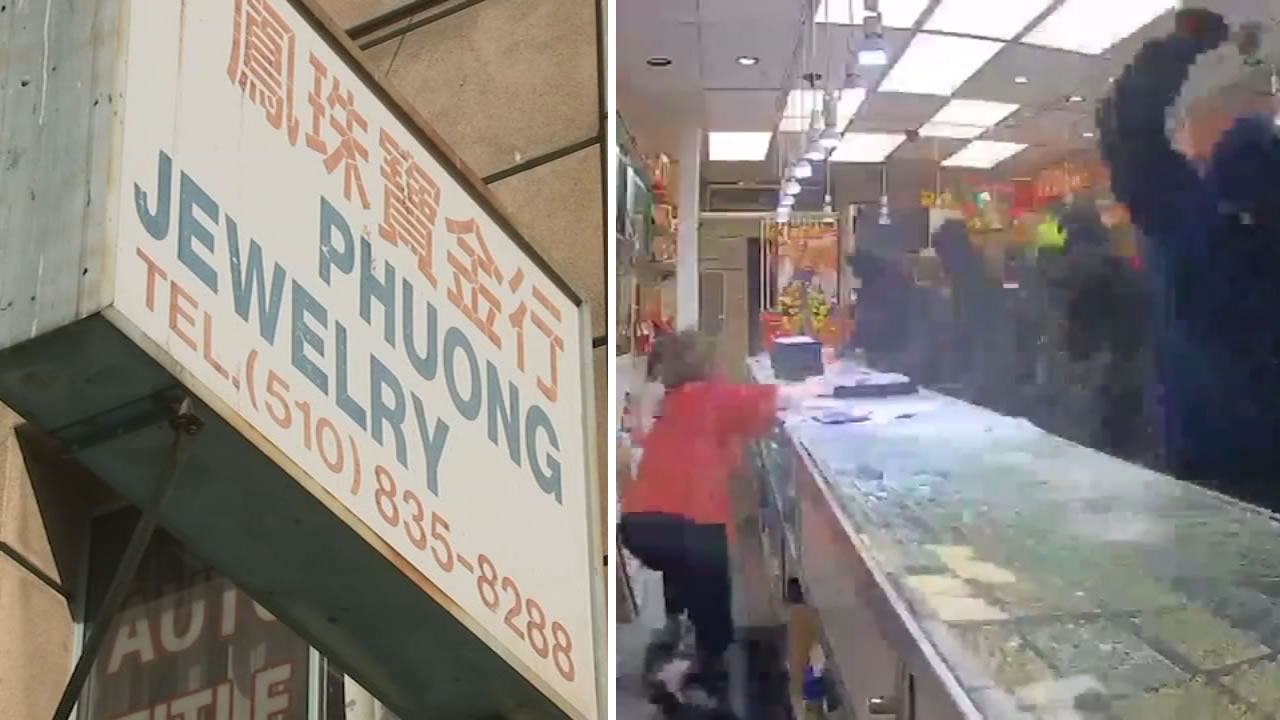
8 armed suspects clear out California jewelry store: VIDEO
Top stories.

AccuWeather: Clouds dominate this weekend, then a big warm up

Regulators close Philadelphia-based Republic First Bank

Philadelphia Eagles 2024 NFL draft picks: Selection analysis

Homeowner's jewelry stolen during 'distraction burglary,' police say
- 2 hours ago

Protesters on Penn's campus told to disband encampment immediately
- 3 hours ago
Eagles select CB, EDGE on 2nd night of NFL Draft
- 24 minutes ago
Man, 76, charged with killing his wife & daughter in Chester Co. home
Man attacks woman on Kelly Drive after asking for lighter: Police
Lexus announces Canadian pricing for the 2025 NX series
Digital car keys: do the benefits outweigh the risks , keep on keeping on: joe dirt’s dodge charger auctions for $425k, eight is great: 8 greatest dodge challengers and chargers, how toyota's 2024 land cruiser compares to 4runner, wrangler, and bronco, what is cruise control a comprehensive guide.
When the system is set, cruise control will maintain a steady speed for your vehicle
You can save this article by registering for free here . Or sign-in if you have an account.
Article content
Your vehicle’s cruise control system unlocks numerous benefits at the touch of a button — but according to web search data, drivers still have plenty of questions about what it is, what it does, and how it works.
What is Cruise Control? A Comprehensive Guide Back to video
Below, we’ll answer some of the most popular Internet search questions about cruise control, so you can make the best use of this important system.
What is Cruise Control?
With cruise control, your vehicle will maintain a steady speed when the system is set.
What is adaptive cruise control?
With adaptive cruise control, the vehicle will also automatically slow down and speed up to maintain a safe position in traffic.
How does cruise control work?
Cruise control work with a manual transmission just the same way it does with an automatic. Drivers set their cruising speed with a button press, and the system works the throttle automatically to maintain the desired cruising speed as evenly as possible. In some vehicles with a manual transmission, pressing the clutch pedal to shift gears turns the cruise control off, requiring an additional button press to reengage it after a gear change.
In other cars with a manual transmission, pressing the clutch pedal simply pauses the cruise control system a moment, allowing drivers to complete their gearshift. When they’ve released the clutch, the cruise control picks up where it left off — no additional button press required.
Is cruise control more fuel efficient?
Yes. Increasing your vehicle’s speed uses fuel. While cruising, even a highly competent driver who isn’t using cruise control will tend to slow down and speed up in a repeated cycle, possibly several times per minute. Though fluctuations in speed may be slight, they do cause your engine to use more fuel than required. Point is, the more time you spend at a steady speed, the less fuel your engine needs.
For most drivers, using cruise control on the highway at 80 km/h can reduce fuel consumption by about 20 per cent. For drivers who find difficulty in maintaining a steady speed and frequently experience big fluctuations, using cruise control can cut fuel use by over 40 per cent.
Depending on what you drive and how fast you drive it, using cruise control could save you between $4 and $20 per hour — based on information from Natural Resources Canada that shows most drivers who don’t use cruise control on the highway will tend to experience a 10 km/h speed fluctuation about three times per minute.
Drivers who have the most difficulty managing their cruising speed could be using 60 per cent more fuel than they need to.
Is cruise control bad for your transmission?
No. Your vehicle’s engine, transmission and other components are designed to work hand-in-hand with its cruise control system and are extensively tested and integrated with one another for trouble-free performance.
Using cruise control also reduces wear and tear on both your engine and transmission by running things more smoothly and steadily, and reducing workload on both components.
Can you add cruise control to a car?
Yes. Depending on the year, make and model, cruise control may be available for add-on or retrofit. Professional installation is recommended, and you’ll want to talk to a professional about the specific availability of parts and integration for your vehicle.
In many cases with modern cars, it’s generally easier and more cost effective to just opt for a unit equipped with cruise control from the factory. Cruise control is widely available as standard equipment on most modern vehicles.
Can cruise control get stuck?
Yes , but it’s extremely rare. Older cable-based cruise control systems seem more prone to this rare problem, in which the cable can slip or bind, making the throttle stick into position. More modern vehicles with electronic throttle and monitoring systems make this problem even less likely.
If the cruise control on your car fails to disengage when you want to slow down, slip the vehicle into neutral to disconnect drive power from the wheels, pull over, and address the situation.
However, chances are, you’ll never experience this problem.
When should cruise control be used?
Any time you’re trying to drive at a constant speed. Whether around town at 60 km/h, in a residential area at 40 km/h, or out on the highway at 105 km/h, switching the cruise control on makes for a smoother and more fuel efficient drive that’s easier on your engine and transmission. it can also help you do your part to maintain the steady and efficient flow of traffic.
Most cruise control systems can be engaged at speeds above 30 km/h.
When should cruise control not be used?
Any time you can’t safely drive at a steady speed. If the road surface is snowy, icy, slushy or very wet, you’ll want to think twice about switching your cruise control on.
In older cars, having your cruise control engaged on a wet or icy road could allow the vehicle to accelerate or experience wheelspin when driven wheels encounter a low-traction surface. Here, the cruise control system maintains throttle pressure, even in situations where it should be released instead. This could lead to a loss of control.
In more modern vehicles, electronic monitoring is used to automatically disengage cruise control when one of the following happens:
- one or more wheels slip
- one or more wheels leave the surface of the road after a major bump or dip
- the wipers are set to the maximum speed setting in heavy rain
Use your judgement. Safely navigating certain slippery or dangerous driving conditions requires careful manual control of your vehicle’s throttle, and in these situations, you’re best to leave the cruise control off.
What causes cruise control to kick off?
If the cruise control in your vehicle suddenly kicks off, a few things may be to blame.
Sometimes, cruise control disengages automatically when the vehicle’s automatic wipers detect heavy rainfall, or when a wheel spins or (briefly) leaves the surface of the road after a big bump or dip. In other situations, there may be a problem with one or more sensors or switches, including the brake pedal switch, throttle position sensor, or one or more wheel speed sensors.
Your modern cruise control system relies on various sensors and switches to do its job properly. As a failsafe, any problem with these sensors can cause the cruise control system to go offline. If you notice this happening regularly, have your vehicle diagnosed by a professional.
Will the cruise control work with an ABS light on?
Probably not. Your car’s Antilock Braking System works hand-in-hand with your cruise control system, and any fault with the ABS system will typically take your cruise control offline until it’s fixed.
An ABS warning light in your instrument cluster can indicate one of several major problems or malfunctions, so be sure to have a professional investigate as quickly as possible.
Will cruise control apply the brakes?
No, but adaptive cruise control will. Standard cruise control (simply called cruise control) holds your vehicle’s speed as constant as possible once set. More advanced adaptive cruise control systems use camera or radar-based sensing to determine the traffic situation in front of your vehicle, and can automatically apply the brakes to maintain a pre-set following distance.
With cruise control, drivers need to brake to slow down as they close in on a slower vehicle in traffic. With adaptive cruise control, the system makes these braking inputs automatically, and the vehicle speeds back up to its pre-set cruising speed once traffic clears.
Before you buy, be sure to determine which type of cruise control system is fitted to the car you’re considering.
What is Super Cruise?
Super Cruise is a next-level driver assistance feature available on certain GM vehicles.
With Super Cruise, the vehicle uses special GPS hardware and sensors to accurately compare its position to a 3D map of pre-qualified highways .
On these pre-qualified highways, Super Cruise allows drivers to go hands-free for extended periods as the vehicle automatically maintains its cruising speed, adjusts that speed for changing traffic conditions, and even precisely follows the curves in the road. It can even make hands-free lane changes.
Super Cruise is not an autonomous system, and in order for it to work, drivers need to keep their eyes on the road — there’s even a camera that monitors the position of the driver’s eyes to make sure they’re focused on the road ahead.
- Evolutionary: The Mercedes-Benz G-Wagen has never strayed far from its roots
- How to jump-start a car—a step-by-step guide
- Testing Mitsubishi’s AWD systems and Snow mode on ice
- 12 things to know about the 2025 Ram 1500 Ramcharger REx
- Ministry of Interior Affairs: How the Range Rover Sport SV's seats vibrate to your music
Justin Pritchard
Justin Pritchard is an experienced motoring expert whose work is read and watched by Canadians across the country on a weekly basis. Starting his career at Auto123.com back in 2005 (while finishing his final year of studies at Laurentian University in Sudbury, Ontario), Justin quickly applied his passion for writing, presenting, and photography, working under some of the most recognized editors in the Canadian motoring scene.
Justin has written one of the largest collections of used car buyer guides on the internet, and his TV program, AutoPilot, has aired over 600 episodes across 16 seasons. Presently, AutoPilot is the only English-language motoring program on Canadian cable TV, though he's lent his informative style and easy-to-identify voice to video features for Youtube, Driving.ca, Autotrader.ca, Motoring TV, and elsewhere. With 4 years as co-chair of the Canadian Car of the Year Awards (CCOTY) program, a passion for vehicle testing shines though in all of his work.
A passion for photography from a young age makes Justin as comfortable behind the camera as in front of it, and capturing motoring memories from the scenery of beautiful Northern Ontario is a priority in much of his work. The particularly harsh winter climate in this part of Canada makes Justin a particular expert on winter driving, winter tires, and extreme-weather safety.
Major awards won by the author
Contact info.
Youtube: @JustinPritchard
Postmedia is committed to maintaining a lively but civil forum for discussion. Please keep comments relevant and respectful. Comments may take up to an hour to appear on the site. You will receive an email if there is a reply to your comment, an update to a thread you follow or if a user you follow comments. Visit our Community Guidelines for more information.
Affordable EVs
Small trucks
Popular Crossover SUVs
Practical 3-row SUVs
Minivans for the whole family
Compact Cars
Luxury SUVs
Affordable AWD SUVs
All things automotive: breaking news, reviews and more. Wednesdays and Saturdays.
- There was an error, please provide a valid email address.
A welcome email is on its way. If you don't see it, please check your junk folder.
The next issue of Driving.ca's Blind-Spot Monitor will soon be in your inbox.
We encountered an issue signing you up. Please try again
Best retrofit Apple CarPlay and Android Auto units
You don't need to buy a new car to add Apple CarPlay or Android Auto.
5 Essential car accessories every driver should buy
There's lots of aftermarket gear out there, but get these add-ons first—they'll make your daily drive more comfortable and safe
The top 5 best motorcycle accessories we've tested
After 40 years of testing motorcycles, these are the five pieces of gear David Booth can’t and won’t live without
Tools you'll need for DIY tire swaps
Changing tires twice a year, it won’t take many seasonal swaps to pay for your investment
Top car organizers to declutter the cabin
Discover some of the top-rated car organizers that will help declutter the car and arrange belongings for a hassle free drive
This website uses cookies to personalize your content (including ads), and allows us to analyze our traffic. Read more about cookies here . By continuing to use our site, you agree to our Terms of Service and Privacy Policy .
Edit your picks to remove vehicles if you want to add different ones.
You can only add up to 5 vehicles to your picks.
You've reached the 20 article limit.
You can manage saved articles in your account.
and save up to 100 articles!
Looks like you've reached your saved article limit!
You can manage your saved articles in your account and clicking the X located at the bottom right of the article.
- Autonomous Cars
GM reveals Ultra Cruise ‘hands-free’ system that covers ‘95 percent’ of driving scenarios
‘ultra cruise eventually can be used on every paved road in the us and canada’.
By Andrew J. Hawkins , transportation editor with 10+ years of experience who covers EVs, public transportation, and aviation. His work has appeared in The New York Daily News and City & State.
Share this story
:format(webp)/cdn.vox-cdn.com/uploads/chorus_asset/file/19881630/acastro_200406_1777_gm_0002.0.jpg)
After years of teases , General Motors is finally pulling the curtain back on its next-generation “hands-free” driver-assist technology.
Dubbed Ultra Cruise, the new system uses sensors like cameras, radars, and lidar to control a vehicle’s steering, acceleration, and braking. GM says the system can be used on 2 million miles of paved roads and in “95 percent” of driving scenarios. Though which vehicles will get Ultra Cruise is still a mystery; GM says it will be available in a handful of premium vehicles in 2023, though the automaker wouldn’t disclose specific models.
The news was announced as part of GM’s two-day annual investor event, in which GM also revealed its plan to double revenues by 2030 as it seeks to become a software company in addition to making cars.
Ultra Cruise will be available in a handful of premium model vehicles in 2023
GM’s first-generation advanced driver-assist system (ADAS), Super Cruise, has been praised as a safer, more capable version of Tesla’s Autopilot, thanks to its camera-based driver monitoring system that ensures drivers keep their eyes on the road. GM says Super Cruise will “co-exist” with Ultra Cruise, with the former available in more “mainstream” vehicles, while the latter is reserved for GM’s luxury models. GM wouldn’t comment on the price customers will be expected to pay to add Ultra Cruise as an option on their vehicles.
Super Cruise, which debuted in 2017 in the Cadillac CT6 sedan , is capable of completely hands-free driving across more than 200,000 miles of divided highway across North America. It compares the vehicle’s position, taken from both GPS and onboard cameras, to its location in a lidar map collected by GM. Once the vehicle knows where it is and that it’s safe to activate, Super Cruise will take over both steering and acceleration.
- GM’s Super Cruise getting fully automatic, hands-free lane changes and more for 2022
By comparison, Ultra Cruise will be much more capable. GM said the system will cover “more than” 2 million miles of paved roads in the US and Canada at launch, with the capacity to grow up to more than 3.4 million miles.
In a call with reporters, GM President Mark Reuss said Ultra Cruise would be able to handle “urban and rural” roads, in addition to stop signs, traffic signals, and other complexities that Super Cruise is currently unable to detect. “Ultra Cruise will do this in a slower environment, urban life as well,” Reuss said. “And again, we’ll have the maps out there to do over 2 million miles, moving to three and a half.”
Despite its enhanced capabilities, GM says it still considers Ultra Cruise a Level 2 system
Jason Ditman, chief engineer at GM, elaborated on Ultra Cruise’s capabilities. “Drivers will be able to travel hands-free across nearly every paved road, including city streets, subdivision streets, and rural paved roads,” Ditman said.
Ditman described Ultra Cruise as a “route following feature” that maintains headways and follows the speed limit. Ultra Cruise will also support automatic and on-demand lane changes, left and right hand turns, avoid close objects, and enable parking in residential driveways.
:format(webp)/cdn.vox-cdn.com/uploads/chorus_asset/file/8301347/Cadillac_Super_Cruise_Hero_Shot.png)
Ultra Cruise-enabled vehicles will come equipped with lidar, which historically is rare for production vehicles thanks to the high costs associated with the laser sensor. “The sensing architecture is all new,” Ditman said. “There are additional cameras and radars, and we are adding lidar to the vehicle.”
Ultra Cruise won’t be able to handle every driving scenario. Ditman gave the example of a roundabout as a type of complex road condition that the ADAS will not be able to navigate. A light bar in the steering wheel will communicate to the driver when they need to control, sending signals through escalating lights and haptic feedback. A voice assistant will also inform the driver when they need to take the wheel.
GM relied on lidar-scanned high-definition maps for Super Cruise, but Ditman said it wasn’t practical to map all 2 million miles of road for Ultra Cruise. “We do rely on similar map data,” he said. “However, we have a larger number of sensors that also observe the roads so when we combine the map accuracy with what our sensors see of the road geometry and the road markings, we’re still able to accurately place ourselves and drive the right nominal path.”
Ultra Cruise won’t be able to handle every driving scenario
Despite its enhanced capabilities, GM says it still considers Ultra Cruise a Level 2 system, as defined by the Society of Automotive Engineers. At Level 2, the vehicle can control both steering and acceleration and deceleration, as well as monitor blind spots and even change lanes automatically. But it falls short of full autonomy because a human sits in the driver’s seat and can take control of the car at any time.
Level 2 systems aren’t infallible. Notably, Alphabet’s Waymo abandoned its plans to develop a Level 2 ADAS after determining that a fully autonomous system would be far safer. And certain automakers’ advanced driver-assistance systems often fail when driving into sharper curves, according to the Insurance Institute for Highway Safety.
The federal government is paying more attention to ADAS, recently announcing that automakers would be required to report incidents involving driver assistance and autonomous systems within one day of learning of a crash.
I traded in my MacBook and now I’m a desktop convert
Blizzcon 2024 has been canceled, the walls of apple’s garden are tumbling down, tesla’s autopilot and full self-driving linked to hundreds of crashes, dozens of deaths, columbia university has a doxxing problem.
More from Transpo
:format(webp)/cdn.vox-cdn.com/uploads/chorus_asset/file/25287483/Scout_Motors_Inc_Front_Design_Teaser.jpg)
Scout Motors wants to put the ‘mechanical’ back into electric trucks
:format(webp)/cdn.vox-cdn.com/uploads/chorus_asset/file/24289218/226446_Lucid_Air_TStevens_0008.jpg)
Lucid slashes prices for its luxury EVs for the third time in seven months
:format(webp)/cdn.vox-cdn.com/uploads/chorus_asset/file/24822928/cadillac_escalade_super_cruise.jpeg)
GM is preparing for another major expansion of its hands-free Super Cruise system
:format(webp)/cdn.vox-cdn.com/uploads/chorus_asset/file/23986648/acastro_STK086_03.jpg)
Tesla’s latest update takes aim at cold weather woes
- GTA 5 Cheats
- Print on a Chromebook
- Nothing Phone 2 Review
- Best YouTube TV Alternatives
- Asus ROG Ally vs. Steam Deck
- Gameshare on Nintendo Switch
What is adaptive cruise control?
It’s not a stretch to call cruise control one of the earliest driving aids. It wasn’t always electronic, and it certainly didn’t make your grandfather’s 1982 Cadillac Seville autonomous, but it was a revolutionary invention. (Although here’s a fun fact: Your grandfather’s Buick had the first infotainment system way back in 1986.)
What to look for in an adaptive cruise control system
What do automakers call adaptive cruise control, are there aftermarket adaptive cruise control systems, who does adaptive cruise control best.
Adaptive cruise control takes it to the next level. It maintains a set speed for your vehicle, like a conventional cruise control system, but it also adjusts the speed based on the traffic flow. Better systems can come you a full stop in heavy traffic and continue when congestion lightens. This technology can make cruise control more useful by taking some (but not all) of the workload off the driver. Here’s what it is, and how it works.
The concept is simple: Make the car accelerates and decelerates automatically depending on how quickly the cars around it are moving. The devil’s in the details, however.
- GM to cut funding for beleaguered driverless startup Cruise, report claims
- Cruise woes prompt production halt of fully driverless van
- Cruise autonomous vehicle drives over woman just after she was hit by another car
To do it, a car must be equipped with sensors that allow it to detect nearby vehicles and potential obstacles. Most adaptive cruise control systems use radar, with high resolution radar on the horizon, although a camera and lidar (which works on the same principle as radar, but with light waves) can be used as well. You can often spot these cameras integrated into the grille or mounted behind the windshield. These sensors communicate with a computer that controls the throttle and, sometimes, the brakes and the steering system.
In its most basic form, adaptive cruise control technology only handles acceleration and deceleration, usually by following the car in front and maintaining a set following distance. Some automakers have started bundling this feature with a system that can bring the car to a full stop if needed, which comes in handy in a traffic jam, and/or one that provides a limited amount of steering assistance to keep the car centered in its lane.
Adaptive cruise control is at the center of the pile of electronic driving aids some automakers believe could form the basis of fully autonomous driving . We’re nowhere near autonomous cars, though, and it’s important not to mistake adaptive cruise control and other related technologies for full autonomy. These systems are designed to help the driver, not to drive the car themselves while the driver dozes off or counts blue cars going the other way.
Adaptive cruise control is sometimes known as dynamic radar cruise control or intelligent cruise control, and most automakers give the system brand names to make it more marketable. Regardless, the basic idea is that a car accelerates and decelerates automatically depending on how quickly the cars around it are moving.
BMW: Active Cruise Control, Active Cruise Control with Stop and Go Cadillac: Super Cruise Honda and Acura: Adaptive Cruise Control, Adaptive Cruise Control with Low-Speed Follow Hyundai: Smart Cruise Control Kia: Advanced Smart Cruise Control Mercedes-Benz: Active Distance Assist Distronic Nissan and Infiniti: Intelligent Cruise Control, a part of Nissan’s ProPilot 2.0 system Subaru: Adaptive Cruise Control, Adaptive Cruise Control with Lane Centering, part of the brand’s EyeSight package Tesla: Autopilot Toyota and Lexus : Dynamic Cruise Control, Dynamic Cruise Control with Stop and Go
This is one technology that cannot easily be retrofitted to an existing car. The complexity of adaptive cruise control systems puts them beyond the reach of the aftermarket. Considering that these systems can mean the difference between a car driving along and a car smashing into the back of another vehicle, concerns over liability will probably keep adaptive cruise control firmly within the domain of the original equipment manufacturers for the time being.
Like systems available from other automakers, Cadillac’s Super Cruise allows the car to accelerate, steer, and brake without driver intervention on highways. But Cadillac is the only automaker to specifically claim that drivers can take their hands off the wheel. That’s because Cadillac did a thorough job in setting up Super Cruise. Not only does the system rely on an array of cameras, radar, and lidar, but Cadillac also mapped 200,000 miles of highway. Super Cruise also has a driver-facing camera, and will only work if a certain level of driver alertness is maintained.
It’s too bad Super Cruise isn’t widely available, at least, not yet. Cadillac launched the system on its flagship CT6 sedan but has been slow to expand to other models. With the CT6 set to be discontinued, Cadillac finally announced that Super Cruise will be available on the CT4 and CT5 sedans when they go on sale in the coming months. Those sedans use a new electrical architecture that can support Super Cruise.
Subaru’s EyeSight system uses cameras instead of radar, bringing down its cost and making installation of the hardware a bit easier. EyeSight bundles adaptive cruise control with lane-keeping assist, a “pre-collision throttle management” feature that cuts the throttle ahead of an anticipated collision, and low-speed autonomous emergency braking. On some models, Subaru has also added a driver-facing camera to ensure the driver stays alert while these features are in use.
Mercedes-Benz
Mercedes offers one of the most comprehensive adaptive cruise control and driver-assistance suites of any automaker. Its latest Distronic Plus system can keep up with traffic, but also brake the car to a full stop in stop-and-go situations. The system will automatically resume driving if the car remains stopped for less than three seconds; longer stops require a tap of the accelerator pedal or of the cruise control’s “resume” button. A steering-assist feature helps keep the car centered in its lane, and certain versions of the system can initiate lane changes.
Tesla’s Autopilot system has attracted its share of controversy, and the name is a bit misleading considering that a human driver must be kept in the loop, but it’s still one of the most advanced systems of its kind. In addition to following traffic and automatically keeping a car in its lane, Autopilot can execute lane changes with the flick of a turn signal, and negotiate some highway off-ramps. Tesla’s ability to pull data from cars using the system and launch over-the-air software updates means Autopilot has significant potential to improve over time.
It’s no surprise that an automaker obsessed with safety was an early adopter of adaptive cruise control. Volvo was also one of the first automakers to pair the technology with autonomous emergency braking, allowing a car to both automatically follow a vehicle in front and brake if it encounters an obstacle. Volvo’s latest Pilot Assist II system doesn’t need to track a vehicle ahead, can a keep a car centered in its lane, and can operate at speeds up to 80 mph.

Editors' Recommendations
- Beleaguered robotaxi startup Cruise lays off quarter of workforce
- Cruise woes continue as key figures quit the robotaxi firm
- Cruise’s robotaxi service suspended by California regulator
- Cruise says it’s nearing approval for mass production of futuristic robotaxi
- Robotaxi firm Cruise ordered to halve fleet following incidents

General Motors-backed Cruise revealed this week that its fully driverless cars have now traveled more than a million miles, mostly on the streets of San Francisco.
The achievement comes just 15 months after the company’s first fully driverless ride, during which time it also launched San Francisco’s first paid driverless robotaxi service.
Cruise’s autonomous cars are heading to Texas and Arizona before the end of this year.
The General Motors-owned company plans to launch ridesharing pilots in Austin and Phoenix in what will be its first expansion of the service outside of San Francisco.
General Motors autonomous car unit, Cruise, has started to offer driverless rides to residents of San Francisco as it moves toward the launch of a full-fledged robo-taxi service.
Following a test run of the service last week, Cruise has released a video (below) showing the reaction of the very first passengers as they rode through the streets of the Californian city in a vehicle that had nobody behind the wheel.
- What's My Car Worth?
- Buyer's Guide
Cars with Adaptive Cruise Control: Everything You Need to Know
Cars with adaptive cruise control used to be considered a luxury only featured in state-of-the-art vehicles. Still, with technological advancements, adaptive cruise control is now a common feature found in many different car models.
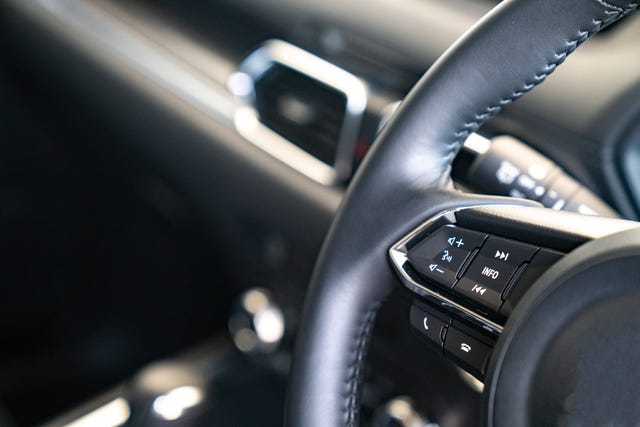
Cars with adaptive cruise control used to be considered a luxury only featured in state-of-the-art vehicles. Still, with technological advancements, adaptive cruise control is now a common feature found in many different car models. Autobytel says this means ACC is now accessible to everyone, and even if your current vehicle doesn't have ACC, you can always have it installed.
What Does Adaptive Cruise Control Do?
Adaptive cruise control uses advanced sensory technology to determine your car's speed in proximity to other vehicles or objects on or around the roadway. It applies moderate brakes and warning signals when a driver is getting to close to another car. Drivers can set the speed limit on the ACC so that they don't exceed the speed limit, but when the sensory technology detects traffic or other unsafe conditions, it reduces the driver's speed to adapt to them.
The Best Cars With Adaptive Cruise Control
1. 2020 bmw 3 series.
This brand new model offers the best combination of sensory technology . It uses cameras in addition to ultrasonic and radar sensors to pull data about the environment surrounding the vehicle. In addition to its sensory features, it also has a "stop-and-go" brake feature, great for commuters who spend extended amounts of time in stand-still traffic as it alleviates the stress on the driver's legs and feet. What's more, the camera sensor can pick up traffic signs such as speed limit signs and reduce or increase speed to match the recommended rate of speed.
2. 2020 Volvo S60
This new model by Volvo has a "Pilot Assist" feature, which makes driving safe and easy. What this feature does is it helps the driver maintain the proper speed with neighboring vehicles, and it also provides steering assistance along with automatic braking or accelerating for situations such as stop-and-go to free-flowing traffic. Another great aspect of this model is that it doesn't rely on a lead car to determine speed and spacing, so you can use it even when you aren't near another car.
3. 2020 Hyundai Sonata
This new Hyundai model has the same technological systems as other Hyundai models, called "SmartSense advanced driving assistance systems." The 2020 Hyundai Sonata includes SmartSense features such as five cameras, three radar sensors, and 12 ultrasonic sensors to help with things such as advanced cruise control, stop-and-go feature, warning signals, and automatic braking or accelerating.
4. 2020 Nissan Altima
The 2020 Nissan Altima features Nissan's "ProPilot Assist" system, which uses advanced technology to help drivers practice safe driving. It allows drivers with automatic acceleration and braking for speed and distance control, while it also uses automatic steering to help them maintain lane control. These helpful features are made possible by its front-facing cameras, sensors, radar, and electronic control module.
5. 2020 Toyota Corolla Hatchback
This new model provides drivers with an adaptive cruise control system, specifically designed for highway travel. Its cruise control features include cameras within the car and radar sensors on the front grille that can gauge your car's proximity and speed when compared to other vehicles around you. Similarly, these sensors help determine the rate of speed of the vehicle in front of you and automatically decrease your speed if the vehicle in front of you slows down.
The Cheapest Cars With Adaptive Cruise Control
According to U.S.News, here are some examples of the cheapest cars you can buy that still have adaptive cruise control features:
1. 2019 Kia Soul
You can get Kia's "smart cruise control" feature as part of their "Primo Package." This add-on is around $4,500 in addition to the original selling-price. You can save energy with its automatic braking system, and also keep a safe following distance thanks to its forward-collision warning feature. In addition to these safety features, the Kia Soul also provides drivers with a heated steering wheel, and in-depth seat adjustments to meet more complex needs for your body type.
2. 2018 Mazda 3
The 2018 Mazda 3 provides drivers with an adaptive cruise control system that detects rear-cross traffic and blind-spot monitoring, great for making safe lane changes. It also offers a "premium equipment package" for just $1,600 in addition to the original selling price. This package gives your vehicle advanced safety features and other add-ons such as a heated steering wheel and a built-in navigation system.
3. 2018 Hyundai Sonata
The 2018 Hyundai Sonata offers buyers the "technology package" for just $1,000. Included in this package are adaptive cruise control to help drivers maintain a safe following distance and adequate speed. This model also comes with a turbocharged four-cylinder engine.
4. 2018 Toyota Rav4
This 2018 Toyota Rav4 SUV includes an adaptive cruise control system for a fee that increases the original selling price to just above $25,000. When you turn your ACC feature on, it uses its radar sensors to administer collision warnings, automatic braking, and acceleration to make sure that your vehicle moves at a safe pace and maintains an appropriate following distance from other vehicles on the roadway at all times.
The 2018 Toyota Rav4's adaptive cruise control system is categorized as "standard equipment" in Toyota's "Safety Sense P suite of technology," Making it a high-tech safety vehicle for a reasonable price point.
5. 2018 Honda Accord
The 2018 Honda Accord features a state-of-the-art adaptive cruise control system called the "Honda Sensing System." This system offers not only adaptive cruise control but also several other useful safety features, including automatic braking for collision prevention and traffic sign recognition.
These features are powered by camera sensing technology that can read traffic signs such as speed limit markers and adjust the Accord's speed to fit those speed requirements. You can get even more safety features by upgrading to higher-trims.
As adaptive cruise control becomes more readily available, you can find cheap and affordable car models that include much of the same technology as modern luxury cars.
https://www.autobytel.com/car-buying-guides/features/10-cars-with-adaptive-cruise-control-131148/
https://cars.usnews.com/cars-trucks/cheapest-cars-with-adaptive-cruise-control
https://www.caranddriver.com/bmw
https://www.caranddriver.com/shopping-advice/
.css-1updq97:before{background-color:#000000;color:#fff;left:0;width:50%;border:0 solid transparent;bottom:48%;height:0.125rem;content:'';position:absolute;z-index:-2000000;} Research .css-1e2ieb7:after{background-color:#000000;color:#fff;right:0;width:50%;border:0 solid transparent;bottom:48%;height:0.125rem;content:'';position:absolute;z-index:-2000000;}

Tundra vs. Tacoma: Comparing Toyota Pickup Trucks

Honda HR-V vs. CR-V: Examining the Differences
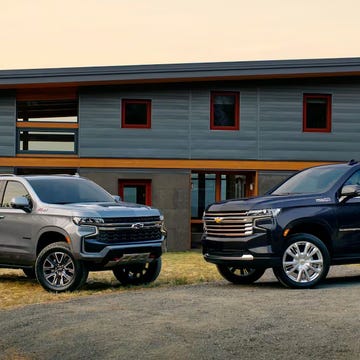
Chevy Tahoe vs. Suburban: Here Are the Differences
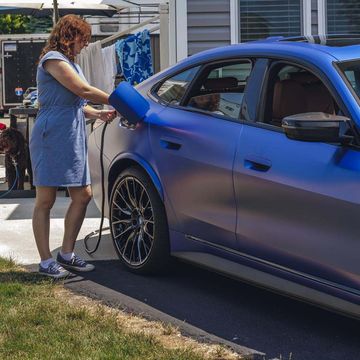
What Are the Different EV Charging Levels?
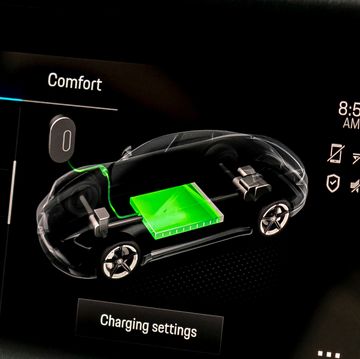
Electric Car Battery Life
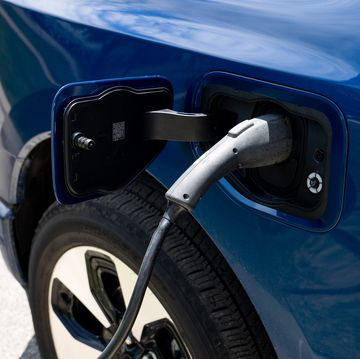
Electric Cars vs. Gas Cars: Pros and Cons

How to Clean Leather Car Seats
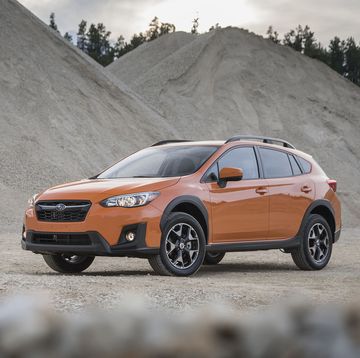
What to Buy: Subaru Crosstrek or Subaru Forester?

What to Buy: Jeep Cherokee or Jeep Grand Cherokee?
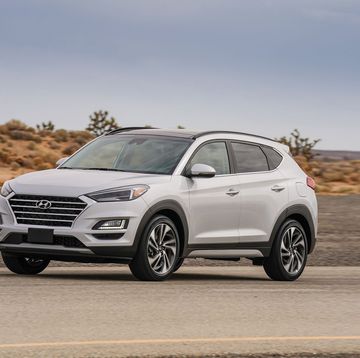
What to Buy: Hyundai Tucson or Hyundai Santa Fe?
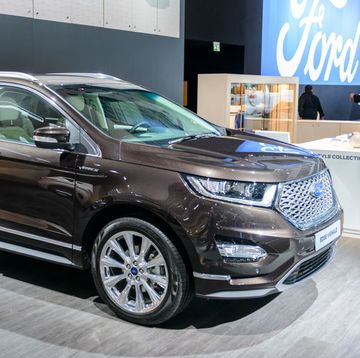
2019 and 2020 Ford Edge Colors
Best viewed in portrait mode
How Cruise Uses Simulation To Speed Up Our Sensor Development

In January of this year, we introduced the Cruise Origin — the first purpose-built, fully driverless vehicle with a million-mile lifespan. It’s self-driven. It’s all-electric. It’s shared. And it’s what you’d build if you could start from scratch to create a transportation system that’s safer, better and more affordable for us, for our cities and for our planet.
The importance of our vision is why, even during a pandemic, we haven’t slowed down. General Motors continues to progress on development of the all-electric propulsion system for the Origin, with the first propulsion system test vehicle already on the roads of one of their massive test facilities in Michigan.
Here in San Francisco, we’ve kept moving forward on AV development using our robust simulation frameworks thanks to the years of data accumulated from on-road testing in one of the most complex city environments in the world.
But that’s not the only cool way we’re using simulation. We’ve also built a bespoke Sensor Placement Tool that uses simulation to help select and place the sensors on the Origin well before the vehicle goes into production. This tool is key to Origin development because it helps ensure overlapping sensor coverage in 360 degrees around the Cruise vehicle — giving us eyes not only in the back of our heads, but on the sides as well. This will enable the Origin to safely perform difficult maneuvers, such as driving around large double parked vehicles while detecting other roadway users, pedestrians and debris.
Placing and evaluating sensors
Cruise’s Sensor Placement Tool accurately enables the virtual placement, evaluation, and iteration of various sensor layouts across three sensor types: camera, radar, and LiDAR. We have accurately modeled the camera’s field of view and distortion, radar field of view, range and point cloud distribution, and LiDAR beam distribution and intensity. These simulated sensors have been refined with rigorous physical evaluation of real world sensor data to cover any unexpected anomalies.
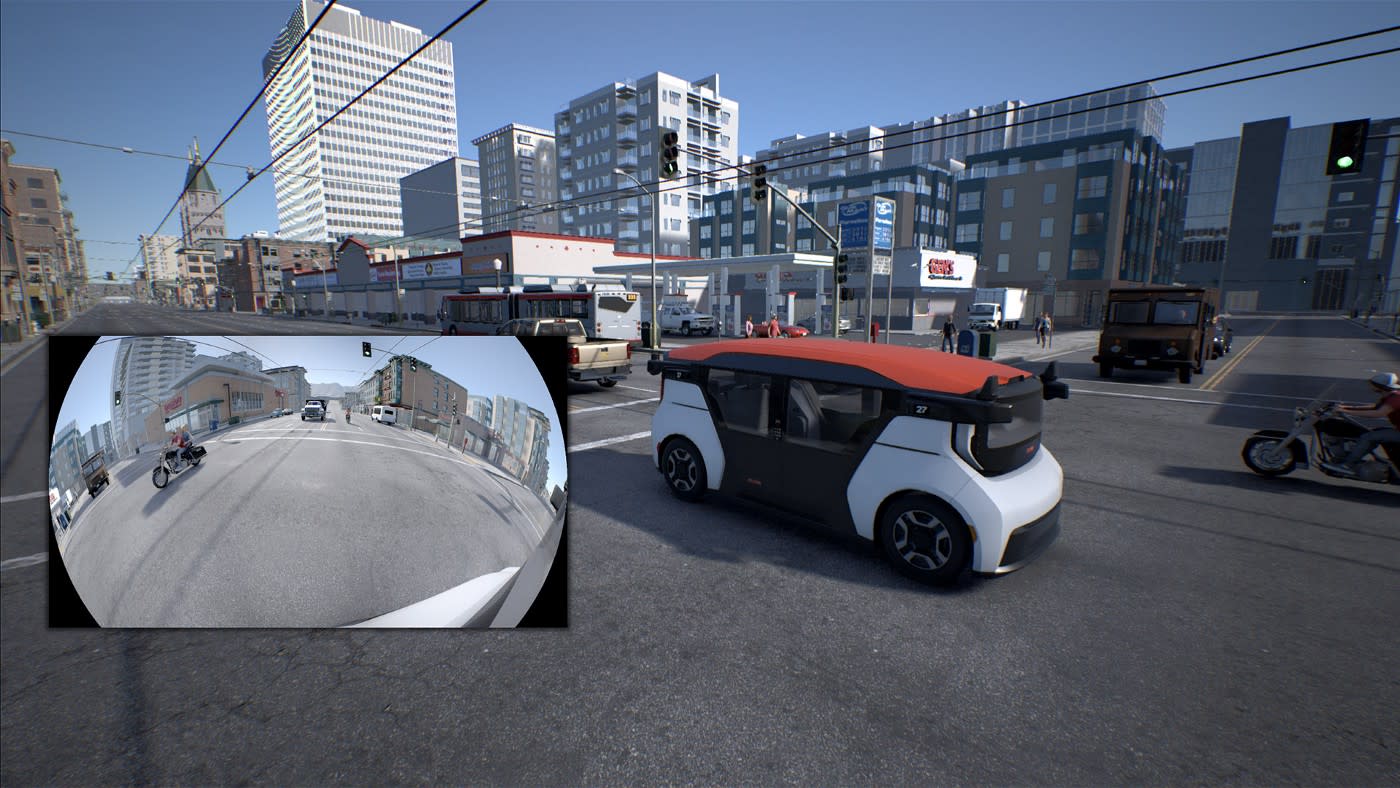
The Sensor Placement Tool also supports the proper offset of the actual optical emission for each sensor from their planned physical housing. This ensures that the virtual sensors mounted in our Sensor Placement Tool are as accurately positioned as possible to their physical, hardware counterparts.
Lastly, we utilize a hardware-accurate CAD-based model of the Origin and load it into the Sensor Placement Tool for frame of reference during placement. This provides proper self occlusions to ensure the most physically accurate representation of the new sensor placement we are testing, including unexpected occlusions with the Origin vehicle body and other sensors such as camera field of view occlusion to radar.
Hardware Development without the Hardware: Allowing for Modular Configuration
With our refined Sensor Simulation, CAD-based Origin, and Sensor Placement Tool, we are able to unlock dynamic modular iteration of the Origin vehicle to greatly accelerate AV development. This functionality enables us to quickly test several sensor configurations and layouts in our tools, which would otherwise take weeks or months with actual hardware. With tight collaboration and review with our Cruise Hardware team, we are able to confidently iterate rapidly with various Origin layouts.
As always, safety is our primary concern. The ability to verify our dual modality/sensor type coverage at any given point with our systems helps ensure our sensor placement is not only performant in terms of maneuvers, but for safety coverage as well.
Using simulation, we are able to test sensors that don’t yet exist in completed hardware form. We can also assess various configurations of existing sensors to evaluate for better modality coverage or occlusion clearance.
Examples of what we can assess include:
Trying cameras with greater or different fields of view or better coverage of a unique area around the Origin while avoiding occlusion from another sensor
Different radar placement for driving at highway speed
LiDARs with different beam patterns and unique orientations to try different configuration layouts for better coverage.
Being able to develop the sensor placement for the Origin virtually in our Sensor Placement Tool significantly expedites development by enabling early decision making for sensor selection, placement, and vehicle design choices without relying on physical hardware. This saves time, lowers costs, and adds flexibility to the Cruise Origin development process.
Optimizing Sensor Calibration using Sensor Simulation
Evaluating and placing sensors is only one part of the production process. Once we have selected a prospective sensor setup, we also need to consider how to calibrate that sensor on the Origin before it hits the road.
Sensor calibration confirms the sensor’s actual position and orientation on the vehicle — AKA extrinsics — which might actually be slightly different than the planned extrinsic placement for the vehicle.
Small differences in each sensor due to manufacturing, shipping, placement, and even jostling on the road can cause differences in the expected vs. actual extrinsics of each sensor. With an accurate and efficient calibration process, we can ensure the Origin will have an effective sensor fusion: combining information from different sensors. Knowing relative position and orientation helps us most accurately combine data.
However, performing calibration is complex and involves an array of fixtures with special markings that enable the calibration system to determine the actual intrinsic (internal sensor configuration) and extrinsic parameters by solving several optimization problems programmatically.
Placement of the fixtures is key and varies for each sensor modality/type. Determining optimal placement for calibration setup can be very time consuming, and once there is a change to sensor layout, that calibration environment must be adjusted as well. Since the Origin can support a variety of sensor layouts, refining this process is paramount to efficient development.
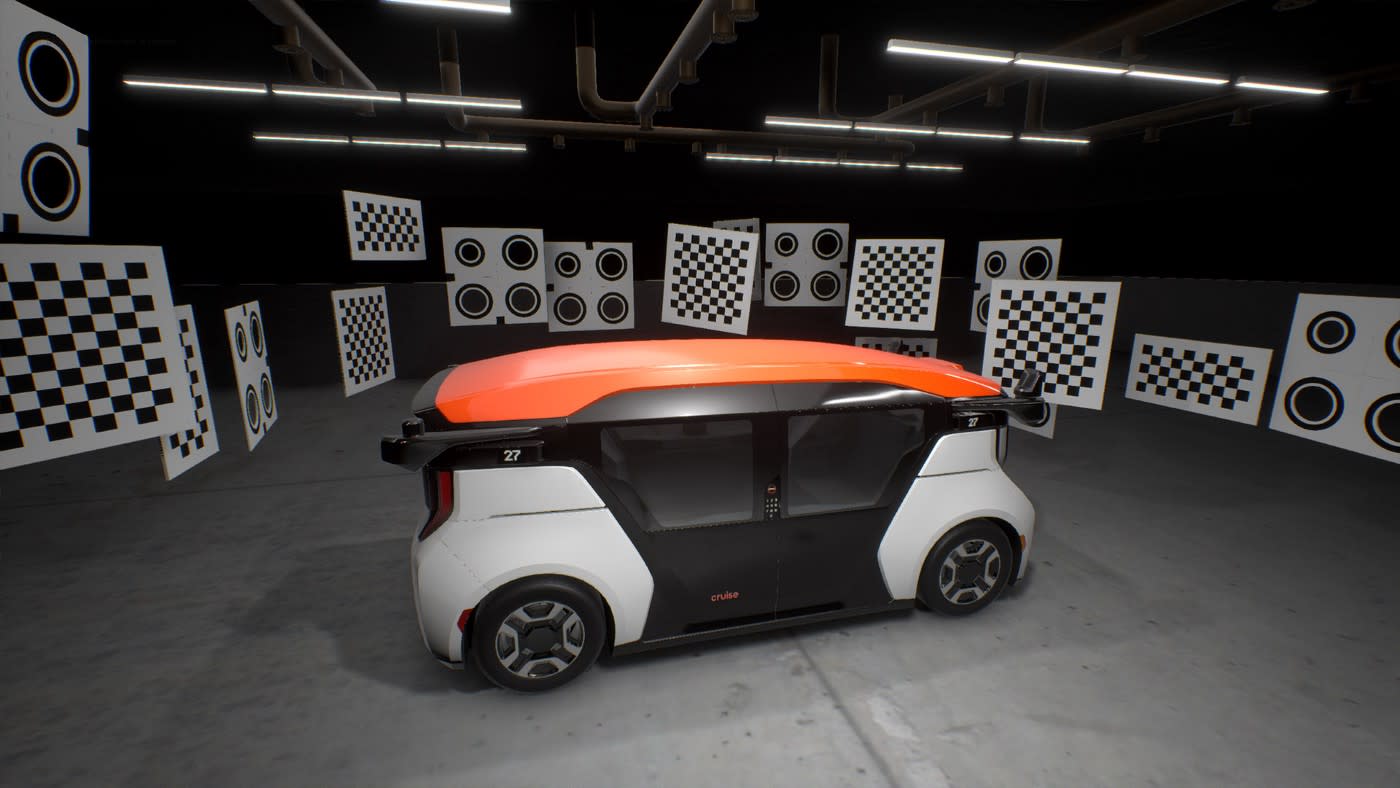
Simulation-accelerated Calibration Setup
Using simulation frameworks, our engineers are able to evaluate calibration setups needed to determine proper calibration. This is all done on a computer in a fraction of the time that it would take to reposition the various fixtures manually.
Once a new calibration method is determined in simulation, it can be built out in real life. Not only is this a faster approach for developing and testing, it’s also potentially less error prone. This is because starting from a simulated environment ensures that the Origin will have perfect calibration by calibrating to a known good simulation setup as opposed to starting from a setup Origin vehicle, which will inherently have some minor calibration offsets (as all manufactured parts do).
Leveraging simulation, various calibration errors can be tested by forcing faulty calibrations into our virtual environment. The calibration system then can be tested for proper determination of the new calibration parameters, thereby further ensuring the best calibration system for our Origin vehicles.
Finally, given that the Origin’s sensor layout is subject to change throughout the development cycle, using simulation frameworks enables us to have accurate and efficient calibration updates to keep up with these changes.
Designing the future of transportation
Simulation frameworks accelerate the development of the Cruise Origin by enabling engineers to determine the sensor selection and placement faster than the weeks or months it would take with actual hardware. Simulation also significantly reduces the costs associated with producing physical hardware while adding flexibility to the Cruise Origin development process.
The sooner we can safely bring the Cruise Origin to the roads of San Francisco, the faster we will be able to deliver the benefits of all-electric, self-driving transportation to our cities: improving safety by removing the human driver, reducing emissions by being all-electric, and alleviating congestion by making shared rides an awesome experience at a radically lower cost.
Utilizing simulation frameworks to expedite the Origin’s production is just one of the complex challenges Cruise is solving. Join our simulation, hardware, and AI teams to create the future of transportation.
What Is Ultra Cruise? Here's How GM's Hands-Free Driving System Works
A suite of advanced systems accompanies gm's driver assist tech.
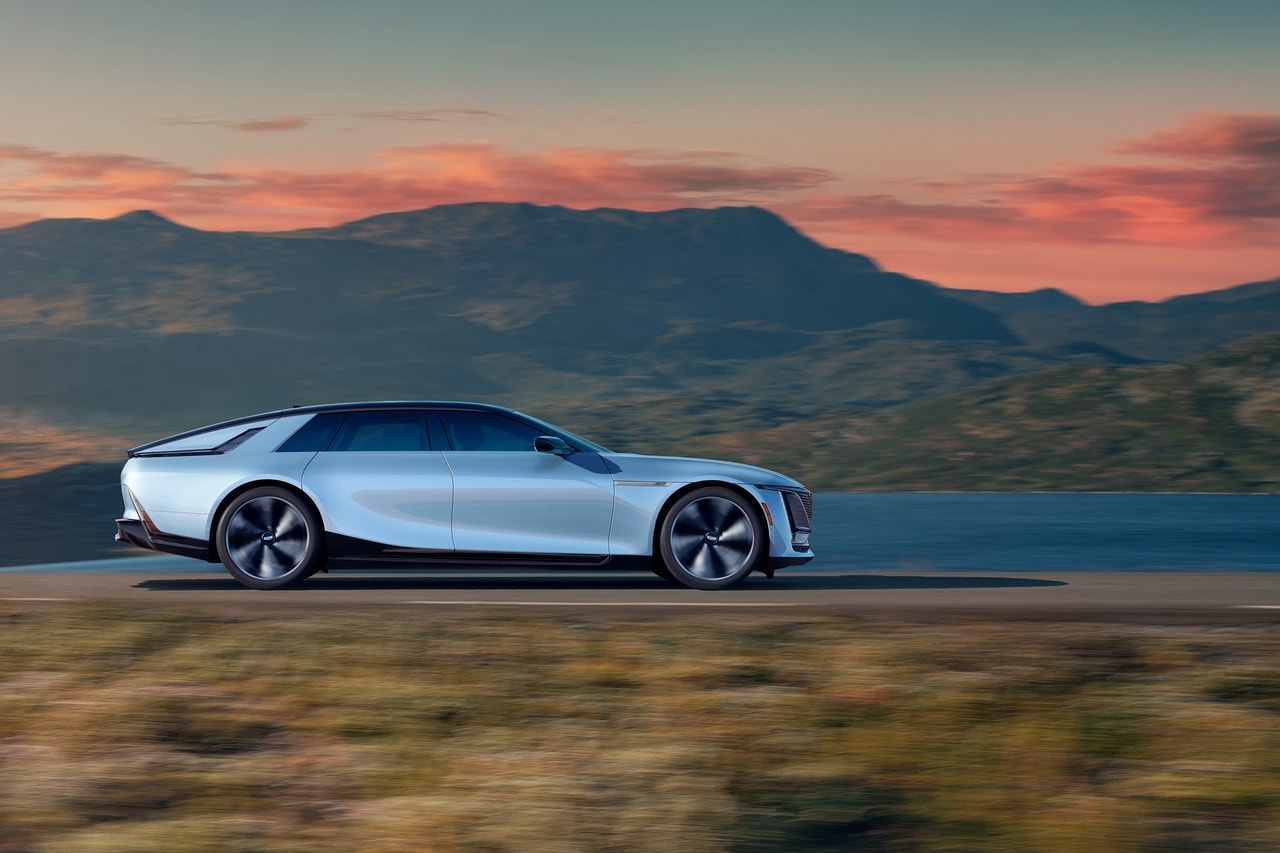
- GM will debut the next iteration of its hands-free driving system, dubbed Ultra Cruise, on the upcoming Cadillac Celestiq.
- Here's what Ultra Cruise is, how it works, and how GM plans on rolling it out safely.
- Ultra Cruise will eventually replace Super Cruise in GM vehicles.
The General Motors Super Cruise system is a suite of advanced driver aids that, in certain circumstances, allows drivers to take their hands off the steering wheel if they keep their eyes on the road. Right now, this high level of assistance requires the equipped vehicle to be traveling on one of the 200,000-400,000 miles (depending on the model) of mostly highway roads throughout the U.S. and Canada that GM has already mapped out. The company wants to take Super Cruise to the next level, but what could be better than Super? Ultra, of course.
Ultra Cruise is the next step in GM's self-proclaimed "path to autonomous" and, like Super Cruise, it's designed as a Level 2 advanced driver assist system ( as defined by the Society of Automotive Engineers ). The plan is for GM to start the rollout of Ultra Cruise on its upcoming $300,000 electric supersedan, the Cadillac Celestiq . Other models will get the tech eventually, but GM is waiting for its next generation of products to open up Ultra Cruise to the masses.
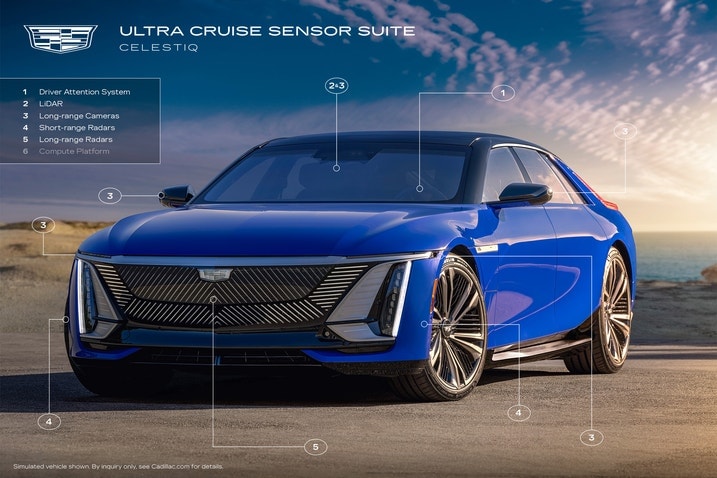
How does Ultra Cruise work, and is it safe?
Ultra Cruise works on the same principles as Super Cruise. With Super Cruise, the vehicle's advanced safety features (including adaptive cruise control, forward collision mitigation and lane centering) tie into the navigation system, which then cross-references positioning information with GM's premapped routes. As long as what the nav and premapped routes agree (i.e., there aren't unexpected lane closures or the road hasn't changed since it was mapped) and the sensors agree it's safe, the driver can activate Super Cruise and take his or her hands off the wheel.
Ultra Cruise builds off Super Cruise with additional sensors (the most notable being the lidar unit behind the windshield) that feed information into an all-new computing system. GM uses sensor fusion (a fancy term that just means all the information is used at the same time) to create a 360-degree, three-dimensional map of the world around the vehicle. Here is a more in-depth summary of what each of these sensors will do, per GM:
- "Compute platform: This is the physical hardware that enables Ultra Cruise. The system will be powered by a scalable compute architecture featuring system-on-chips (SoCs) developed by American semiconductor company Qualcomm Technologies.
- "Long-range cameras: These seven, eight-megapixel cameras are located on the front, corners, back and sides of the vehicle, providing expanded fields of view for Ultra Cruise. They help enable the system to detect objects such as traffic signs, traffic lights, other vehicles and pedestrians.
- "Short-range radars: Placed on the four corners of the vehicle, these radars are used to help sense a radius of up to 90 meters, like pedestrians crossing the street or vehicles in surrounding lanes.
- "Long-range radars: The three 4D long-range radars on the front and back of the vehicle allow for Adaptive Cruise Control speeds as well as lane change maneuvers at highway speeds by helping to detect an object’s location, direction and elevation relative to the speed of the vehicle. They also help the system determine safe stopping distances.
- "LiDAR: The LiDAR, located behind the windshield, helps produce an accurate three-dimensional view of the scene, enabling more precise detection of objects and road features such as vehicles and lane markings, even in inclement weather conditions. Combined with other sensors, it can help create a robust perception of the environment around the vehicle for Ultra Cruise, increasing the system’s functional domain and performance."
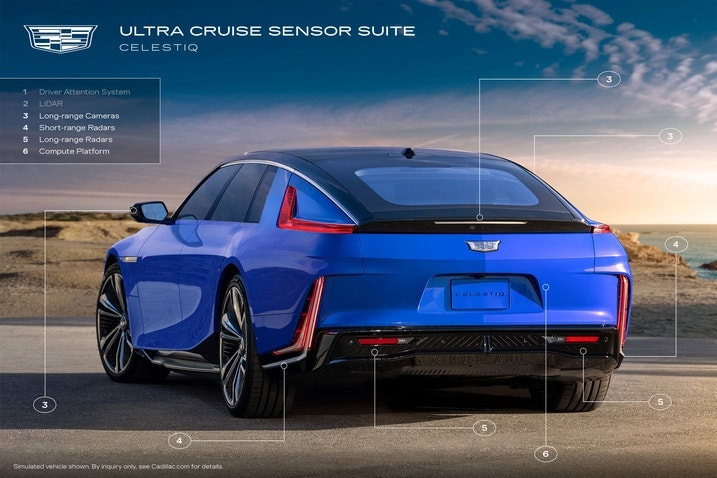
The last part of the sensor array is the driver-attention system. There is a small camera that's located on the top of the steering column — right in front of the car's instrument panel — that uses infrared light to monitor the driver's head position and track the person's eyes. Cars equipped with Super Cruise currently have this tech, and it's a key piece in making sure the systems are used properly.
We can't say for certain that Ultra Cruise is safe, but according to GM, the deployment of this technology revolves around testing and validation, educating customers and working with local Departments of Transportation to take roadwork (which would naturally clash with premapped information) into account. One has to imagine GM will ship Ultra Cruise as a finished product, unlike Tesla, which labels its so-called Full Self-Driving function "beta," or not complete.
GM says the goal is to eventually "enable hands-free driving in 95 percent of all driving scenarios." Right now Super Cruise uses premapped highways and roadways to help give the system a clearer picture of what's around it at all time. We asked GM if Ultra Cruise will use the same mapping systems or if it won't need the mapping at all. A GM spokesperson told us, "Ultra Cruise will offer a destination-to-destination hands-free driving experience [...] Ultra Cruise will use the LiDAR mapping that Super Cruise has on more than 400,000 miles of highways, plus additional mapping beyond Super Cruise’s domain. Stay tuned for more details on Ultra Cruise’s mapping strategy." Which likely means even more premapped roads for Ultra Cruise when it does eventually make its way beyond the Celestiq.
Edmunds says
It might be a while, but cruising from L.A. to Tahoe with Ultra Cruise sounds pretty nice to us.

Nick Yekikian has worked in the automotive industry since 2019. He has written close to a thousand car-related articles and tested and reviewed more than 200 vehicles over the course of his career. Nick is the Senior News Editor at Edmunds and has also contributed to MotorTrend, Automobile Magazine and Super Street. When Nick isn't zipping around town in his latest used-car find, he's probably making digital art in Photoshop or playing disc golf with friends.
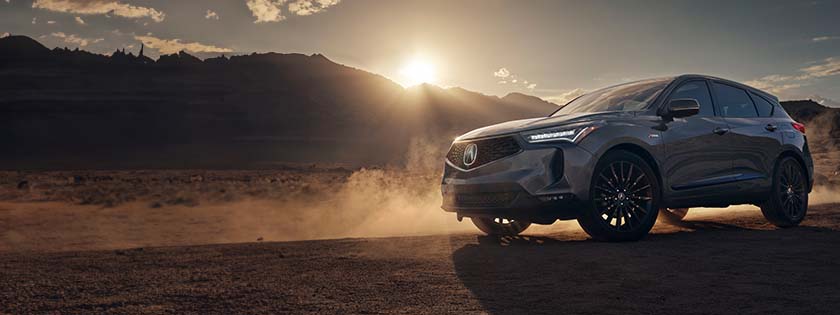
Related information
Other models.
- Used Lexus LS-430 in Hyattsville, MD
- Used Mclaren 765LT in Monroe Township, NJ
- Used Lincoln Town-Car in Petaluma, CA
- Used Audi Allroad in Cockeysville, MD
- Used Land-Rover Range-Rover-Velar in Brighton, MA
- New Toyota Grand-Highlander for Sale in Moscow, ID
- Used Lexus RX-450H in Quincy, MA
- Used Land-Rover Range-Rover-Evoque in Mahopac, NY
- Used Pontiac Torrent in Lima, OH
- New Kia Niro for Sale in West Sacramento, CA
Recent automotive news
- The All-Electric 2025 Mercedes-Benz G-Wagen Is an Off-Road Game-Changer
- Acura ADX Will Join the Brand Lineup as a Premium Compact Crossover
- The Lamborghini Huracán STJ Is a Bittersweet Farewell
- Refreshed 2025 GMC Yukon Gets Massive Infotainment Screen
- Toyota 4Runner vs. Land Cruiser: Which SUV Is Right for You?
- Jeep Wrangler Meets the Steel Bender at Easter Jeep Safari
- The 2025 Corvette ZR1 Is Coming: Here's What We Know
- Chevy Colorado vs. Ford Ranger vs. Toyota Tacoma: All New, But Which Is Best?
- Does Tesla's Future Include a $25K Car, Robotaxi or Both?
- 2025 Porsche Taycan Turbo GT First Drive: The Ludicrous Taycan
Popular new car reviews and ratings
- 2023 Jeep Grand Cherokee
- 2023 Cayenne
- 2024 Alfa Romeo Giulia
- 2023 Santa Fe Sport
- Audi Audi A7
- Alfa Romeo Quadrifoglio Giulia
- Acura RSX 2023
- Hyundai Kona Ev
- 2023 Toyota Camry Hybrid
Lease deals by make
- Buick Lease Deals
- Chevrolet Lease Deals
- Honda Lease Deals
- Cadillac Lease Deals
- Ford Lease Deals
- BMW Lease Deals
- Genesis Lease Deals
- Hyundai Lease Deals
- GMC Lease Deals
- Audi Lease Deals
Lease deals by model
- Honda Odyssey Lease Deals
- Honda CR-V Lease Deals
- Honda Accord Lease Deals
- GMC Yukon Lease Deals
- Jeep Grand Cherokee Lease Deals
- Honda Civic Lease Deals
- Hyundai Kona Lease Deals
- Honda HR-V Lease Deals
- Honda Passport Lease Deals
- Honda Pilot Lease Deals
Join Edmunds
Receive pricing updates, shopping tips & more!

- 📩 Private Emails
- Privacy Policy
- Terms of Sales
Cruise Automation — A Self-Driving Car Startup
Cruise Automation is a self-driving car company whose goal is to deploy safe self-driving cars at scale.
Founded in 2013, they develop self-driving cars that can take passengers from A to B in a safe and comfortable way. I got interested in their system and watched a few videos and interviews to get back to you with a concise analysis.
What’s behind their system? What algorithms are in use? Can they compete with Waymo and Tesla to provide autonomous driving at scale?
Let’s take a look at Cruise Automation…
📩 Before we start, I made a Self-Driving Car Mindmap that you can receive if you join the daily emails .
This is the most efficient way to understand autonomous tech in depth and join the industry faster than anyone else.
How it started
Cruise was founded around 2013 by Kyle Vogt and Dan Kan. Their main activity was highway Autopilot for Audi: Identifying lane lines with a RADAR/Camera system.
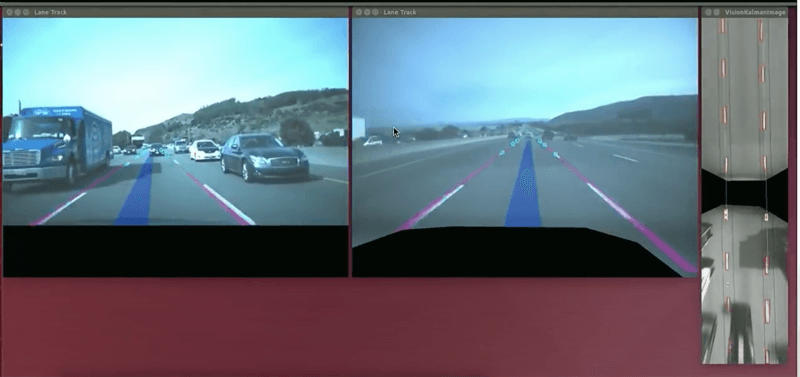
Then, Cruise wanted to do more: and moved to fully autonomous cars:
In 2015, they added LiDAR to allow for urban driving.
The startup went to an acceleration program called Y-Combinator.
A year later, they got acquired by General Motors and grew massively.
They moved the garage a few times, and named all of their self-driving cars after MARVEL’s characters: Scarlett, Iron Man, …
Today, Cruise is a huge team of over 1,600 engineers working to solve on of the most interesting and challenging problem of them all: Urban Autonomous Driving.
Self-Driving Cars in one image

This article will detail the Perception stack, and then briefly mention the rest.
In this interview from 2017 , former Head of Computer Vision Peter Gao described Cruise’s problem as tough and unpredictable.
Funny story, I looked for Peter Gao on LinkedIn and found a second Peter Gao, also working on self-driving cars… but for Waymo.
Cruise’s Perception system uses LiDARs, Cameras, and RADARs. Cameras and RADARs can be a good fit for highway autopilot, but LiDAR adds a lot of information when it comes to urban driving and pedestrian detection.

Let’s start with the camera…
In this article, I’ll mention a process called “Sensor Fusion”… the idea is to fuse data coming from different sensors (for example a camera and a LiDAR) and thus take advantage of both sensors. More on Sensor Fusion here .
How does the Computer Vision system work?
Computer Vision is everywhere in autonomous driving: to find lane lines, obstacles, or even traffic signs and lights… we need to use the camera and Computer Vision algorithms…
Cruise has a process of working in 5 Steps:
Camera Calibration
- Time Calibration — Sensor Fusion
- Labeling — Active Learning
- Big Data — Fleet Management
- Perception Tasks — Detection, Tracking, …
Every camera needs calibration. It helps with 3D geometry, but also to get an accurate image.
Intrinsic Calibration helps with camera image rectification — removing the GoPro effect and thus having a rectified image.
Extrinsic Calibration is a camera/car calibration — it helps with Sensor Fusion and 3D projections later.
In the following image, you can see the results of extrinsic calibration. The closer the object, the greener.
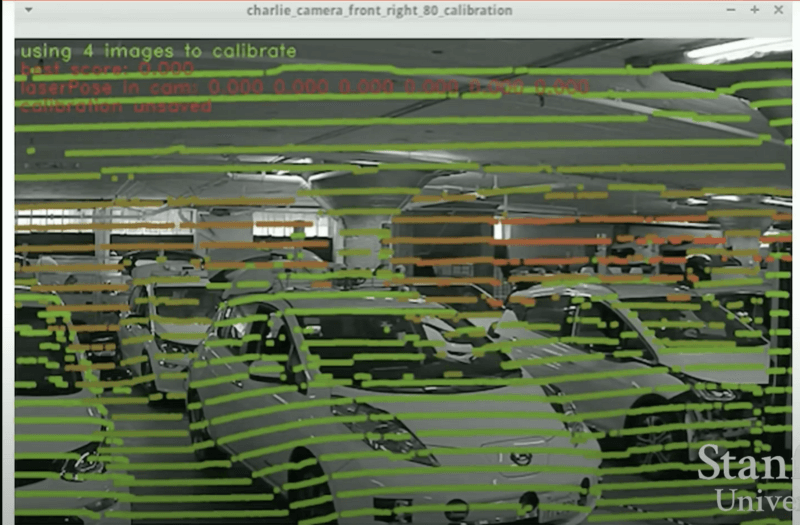
👉 If you’d like to learn more about LiDAR Camera Fusion, I invite you to take my course LEARN VISUAL FUSION: Expert Techniques for LiDAR/Camera Fusion in Self-Driving Cars
Time Calibration
One of the key aspects of Sensor Fusion is to match a frame from a camera to a frame from the LiDAR…but these must be taken at the exact same time!
Time Calibration is made using a process called phase locking: the LiDAR is scheduled to arrive at a certain point of the rotation at a certain point in time.
There is a lot of Machine Learning at Cruise. Labeling is therefore an essential task.
2D Obstacles, tracking, lane lines, freespace, traffic lights and signs, hazard lights, and much more must be detected…

Every vehicle generates hundreds of Terabytes every single day. If you’ve followed my course START WITH ROS , you know that a 20 seconds recording is already over 5 Gb.
The number of cars is set to grow exponentially, and the resolution of cameras as well…
Cruise uses Spark to aggregate data and do cool operations such as query or even multi-machine training…
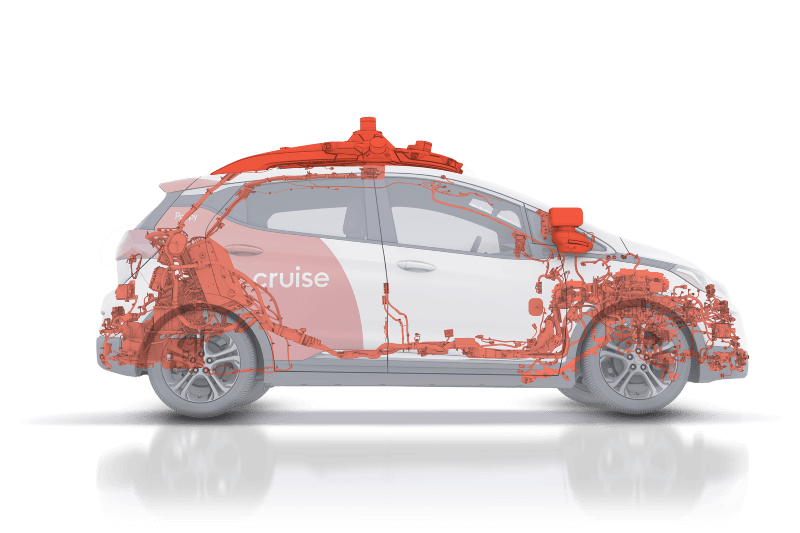
We have a brief idea of the sensors, and the pipeline cruise uses. How do they actually detect obstacles?
Autonomous Driving Tasks
Cruise is doing Urban driving. Urban driving introduces a lot of complex scenarios that are not present in community driving or highway driving. For example, we must detect traffic lights, define and understand what is a double parked cars, overtake a vehicle, predict their moves, …
Traffic Light Detection
Cruise drives primarily in San Francisco, here’s an example of the traffic lights they classified.
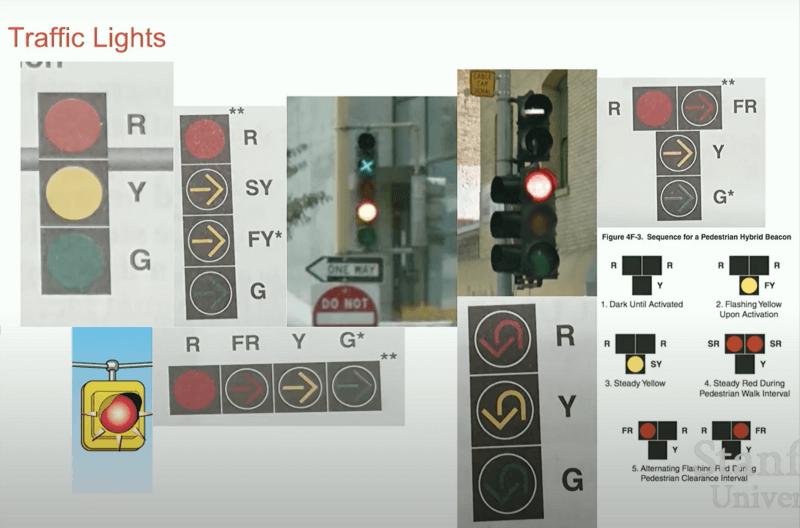
As you can see, the problem is complex : it’s not just green, yellow, and red.
There can be multiple colours, directions, flashing lights, and all of these new things every single day.
The problem is still a classification/obstacle detection one, but with more than the 3 classes you would expect. In reality, traffic lights and signs are some of the most difficult problems due to the diversity of signs we can have for a single class.
As a comparison, it’s only a few months ago in 2020 that Tesla (which leads the automation race so far) announced it can now detect traffic lights.
3D Obstacle Detection & Sensor Fusion
Cruise detects obstacles in 2D, and then transpose them in the 3D space.
How? The 2D obstacles are fused with LiDAR and RADAR 3D features, and then projected thanks to the camera’s extrinsic parameters.
In my Visual Fusion Course , I describe two fusion processes called Early and Late Fusion.
Early fusion is about fusing the pixels and images features with the LiDAR point cloud before even running a detection algorithm. The fusion is the first operation made.
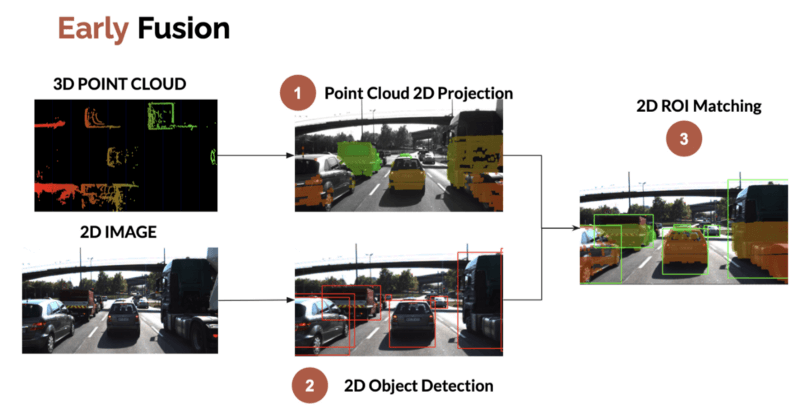
Late fusion is about fusing the independent results: a 2D bounding Box coming from a camera with a 3D one coming from a LIDAR.
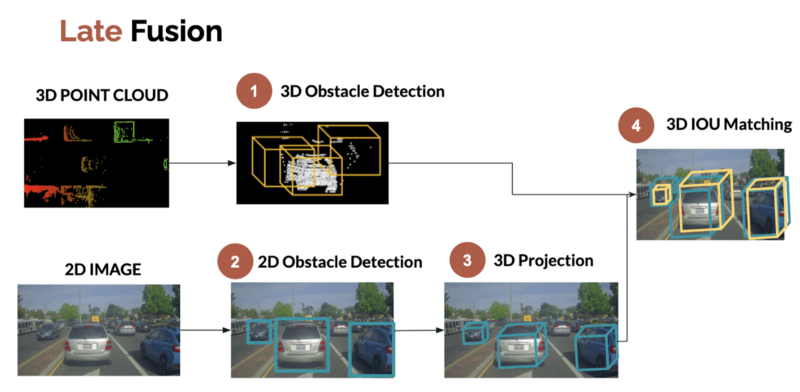
Cruise is doing late fusion: Obstacles are processed individually, and then fused.
In the following image, you can see 2D obstacles (on the left) and their 3D projection (on the right).
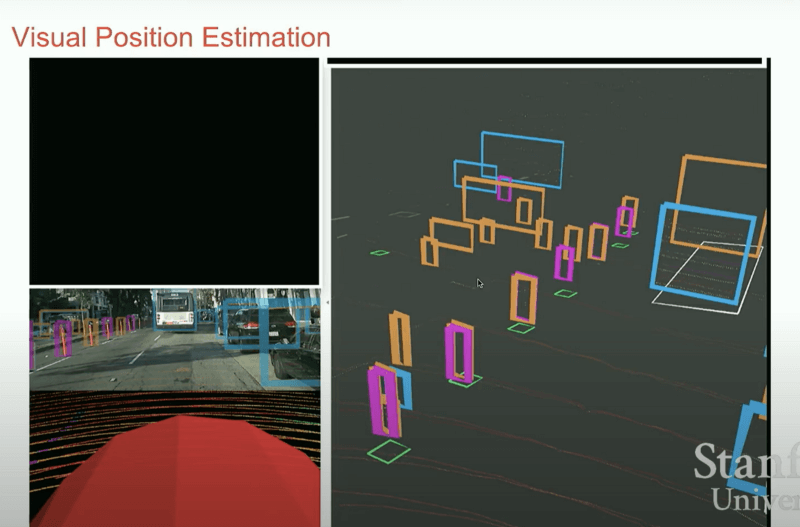
Vehicle Light Detection — Double Parked Vehicles
Cruise drives mainly in San Francisco. When getting used to this city, they noticed something very common: double parked vehicles.
In San Francisco, double parked vehicles are everywhere. Whether it’s legal or not, it happens. A self-driving car has to adapt… or it will never drive over a minute.
From the same source (VentureBeat) — In order to do this, Cruise’s cars must first identify them, which they accomplish by “looking” for a number of cues such as vehicles’ distance from road edges, the appearance of brake and hazard lights, and distance from the furthest intersection. They additionally use contextual cues like vehicle type (delivery trucks double-park frequently), construction activity, and the relative scarcity of nearby parking. […]
And later we can read that Recurrent Neural Networks (RNNs) are used to determine whether or not a car is double parked thanks to their long-term memories. We can’t determine if a car is double-parked using a single frame, we must use a sequence of images.
The Vehicle Light detection model which allows to:
- confirm if a car is parked
- detect if a park is momentarily stopped (hazard lights)
- detect car intents with directionals
The planning system can then adapt: if a car is stopped but with no directionals, it can mean that it’s just paused for a few seconds. So we shouldn’t overtake.
If it’s stopped and has the hazard lights on, let’s overtake.

Those are the core elements of Perception.
Obstacle Prediction
Today, a Cruise vehicle can detect a lot, it can even predict pedestrian and car intents for the future. Every obstacle will have this green arrow representing the future positions.

Prediction is when we take the detected obstacles and project their state (position, velocity) a few seconds into the future…
In my Tracking Pack , I use obstacle detection, Hungarian matching, and Kalman Filters to implement the SORT algorithm that detects, tracks, and predict every obstacle’s position. Cruise is probably using similar techniques too, but when it comes to intersections, it’s purely a learning approach.
Cruise has a fleet of dozens of vehicles: they leverage it.
How? Every vehicle is independently seeing different situations, and can therefore learn from the other vehicles.
Vehicles drove thousands of hours in San Francisco… They learned the trajectories in specific situations. There are some edge cases, a lot of them, but it’s still a learning problem.
In the following image, we can see a simplified vision of their approach…
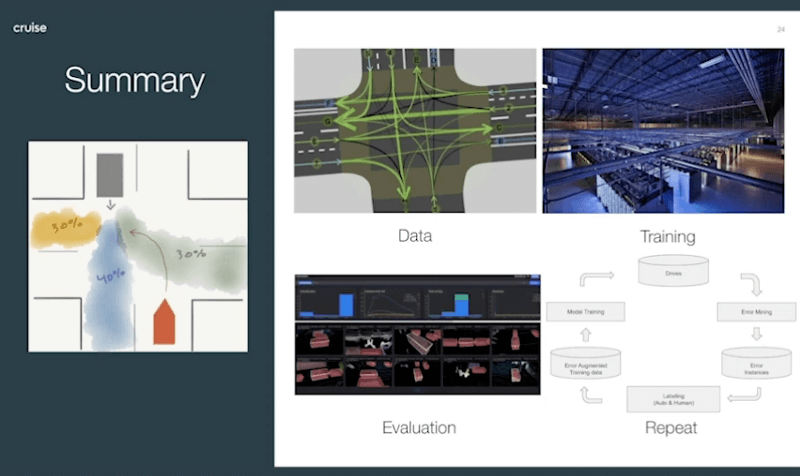
First, we can see that this is a classification problem. The vehicle has a 30% chance of turning right, 30% left, and 40% chance of going straight.
Trajectories are computed, with likely (green) and unlikely (black) ones.
The model is evaluated, and there is a retraining process in a closed feedback loop.
Let’s see it in more detail...
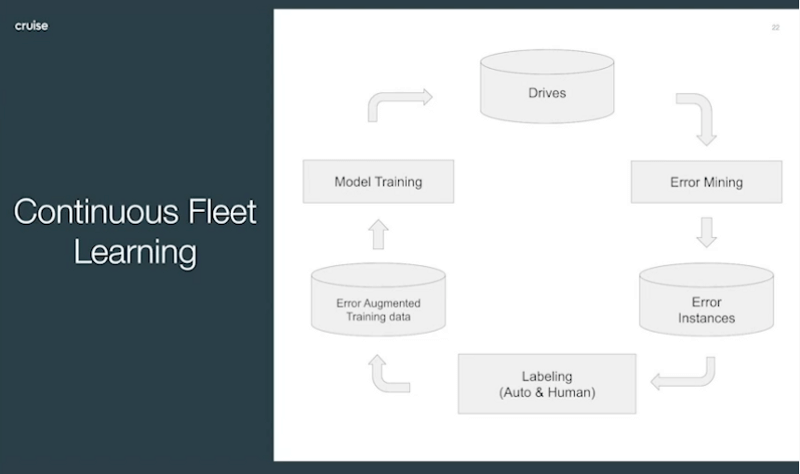
This is similar to an active learning problem : but they call it Continuous Fleet Learning.
Today, Cruise’s system is so much more powerful than what I just quoted.
Cruise has been able to drive for years in San Francisco…
They can do specific maneuvers like unprotected lefts, but they also can drive in streets full of children safely, climb hills, and they only need about 1 operator for every 10 vehicles.
Their system is impressive and very smooth but we don’t know much about their time spent driving outside of San Francisco.
It raises an important question about Company owned Fleet and Customer Owned Fleet.
Tesla is not controlling its fleet, the users are. They can be in the UK, in France, or in the US. And it’s data from all of these countries fed to Tesla’s system.
Cruise decides where the fleet is operating but therefore is not forced to discover new regions.
A final word on the controllers used. The goal of the control command part is to generate a steering angle and an acceleration value to follow the computed trajectory.
Cruise uses a Model Predictive Control algorithm to do so. You can read more about these type of algorithms in my article Control Command in Self-Driving Cars .
Building Self-Driving Cars is a dream, and not an easy one. With their system, Cruise proves that it can compete with the most advanced companies in the world by using state of the art algorithms, and continuously evolving their system.
I built Think Autonomous based on my field experience and with the simple objective to help you join the self-driving car industry. Whatever you decide, just keep that in mind: it’s possible, if you put your mind to it.
Learn more about Cruise—
Some images are from this video , specifically about prediction.
If you’d like to see Cruise in 2020, you can watch this great interview from Cruise’s founder Kyle Vogt .
Cruise built a ROS Visualizer called Webviz. It allows you to see RADAR output, LiDAR point clouds, and camera images. Play with it here .
👉 It’s very similar to the work we do in my course START WITH ROS: Build Real Robotics Applications on the edge that I highly recommend to get closer to real self-driving car building.
Cruise’s interns seem happy 😛 Watch their video here .
You can learn more about Cruise on their website .
- self-driving cars
Interested in Autonomous Systems? Download the Self-Driving Car Engineer Mindmap
Jeremy cohen, recommended for you.
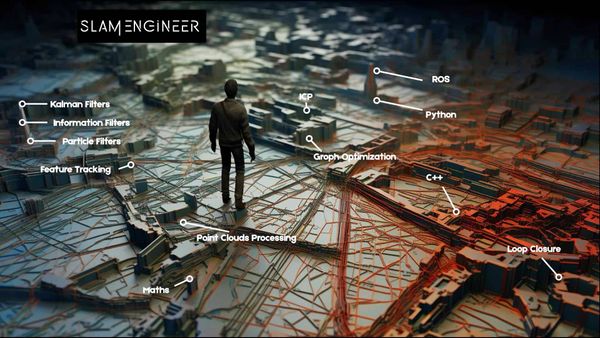
SLAM Roadmap: Which skills are needed to become a SLAM Engineer?
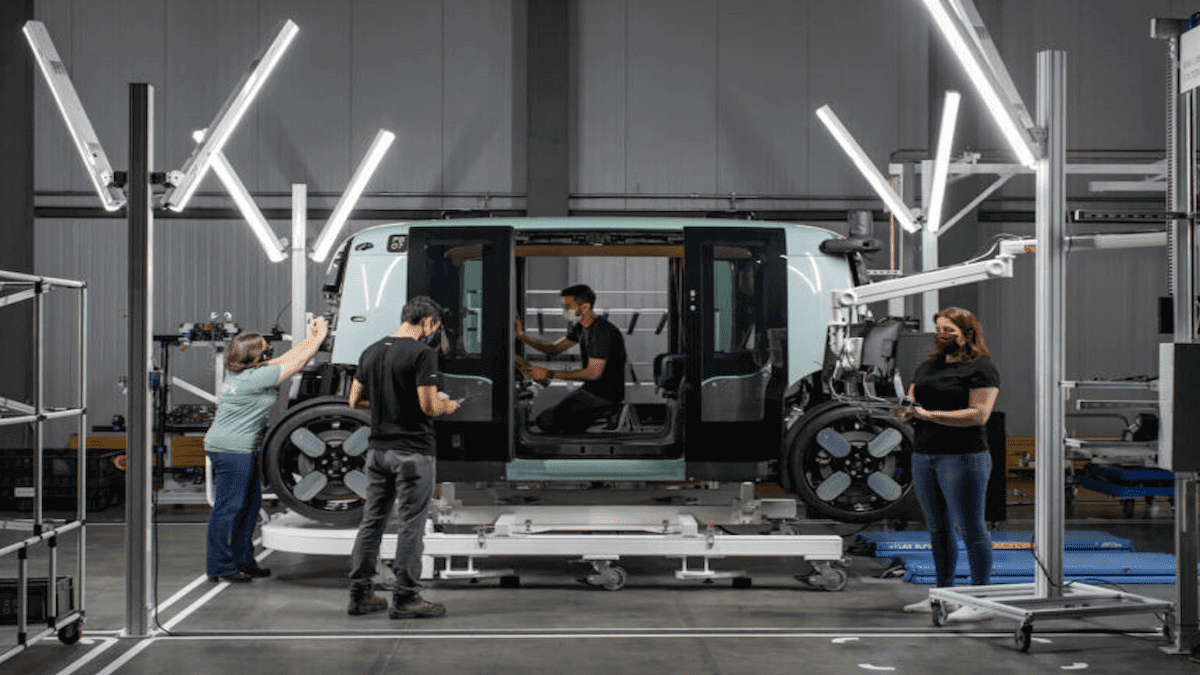
Zoox Careers — Dissecting Zoox's 1,426 Self Driving Car Jobs

I hunted an Autonomous Delivery Robot, here are 7 things I learned
No results for your search, please try with something else.
Cars for sale
Sell my car, car research, sign in, what is adaptive cruise control, this advanced driver-assistance tech can modulate a car’s speed for you..

Article QuickTakes:
- How does adaptive cruise control differ from regular cruise control?
- Are all adaptive cruise control systems the same?
- Which vehicles have adaptive cruise control?
Using forward-facing sensors such as radar and/or cameras, adaptive cruise control (ACC) detects a vehicle in front of you and, working in concert with the brakes and powertrain, automatically adjusts your vehicle’s speed to maintain a safe following distance. This high-tech feature is available on many new cars and can make highway driving or congested-road commuting safer and more relaxing.
How Does Adaptive Cruise Control Differ from Regular Cruise Control?
On an open road, ACC works just like regular cruise control, keeping your car at a set speed. You can increase or decrease your car’s velocity with buttons on the steering wheel, and should you wish to take over, simply press the accelerator to temporarily override the system (say, to pass someone) or tap the brakes or steering-wheel button to cancel it. Once ACC detects a slower-moving vehicle in your path, though, it will lower your car’s speed for you, by reducing the vehicle’s power or even applying the brakes to keep your car a reasonable distance away from the vehicle ahead of you. If the slowpoke you’re following begins to move faster, ACC will tell your car to accelerate to match it up to your set speed. Just how big of a gap does ACC leave between you and the car ahead? That depends on how quickly you’re traveling, as faster-moving vehicles need more room to stop than slower ones, and your comfort level, as many systems allow drivers to adjust the gap length via a button on the steering wheel.
Are All Adaptive Cruise Control Systems the Same?
Not all ACC systems work at every speed, but the most advanced have what’s known as stop-and-go operation. This means ACC can bring the car to a complete halt, perhaps behind a vehicle at a red light, and then get it going again as the car ahead of it moves forward. Depending on how long the stop is, you may have to push the accelerator to resume ACC. It’s a particularly useful feature in heavy traffic, as letting the car deal with road congestion allows you to relax a little. A couple of systems—such as the one offered by Mercedes-Benz—can work with traffic-sign recognition and automatically adjust the vehicle’s speed to the posted limit as it changes. Before you let your car take over braking and acceleration, though, know that ACC typically won’t respond to pedestrians or stationary objects, and many systems struggle to make sense of motorcycles.
Which Vehicles Have Adaptive Cruise Control?
Since debuting in the U.S. in the 2000s, ACC has become widely available. Subaru now installs it in every model with an automatic transmission, for instance. But it’s not standard across the industry. Some automakers bundle ACC with other features in option packages, as Ford does in the F-150 with Ford BlueCruise , or restrict the tech to more costly trim levels, as Chevrolet does with the Equinox compact SUV. Like Wi-Fi at a high-end hotel, ACC is often an extra-cost item on luxury vehicles, too. For instance, in the lowliest GLC and GLE SUVs, Mercedes-Benz makes buyers spec a pricey package for ACC. And it’s not even available on the base Audi Q3 and Q5.

Related Articles

Available Super Cruise hands-free tech is just the tip of the iceberg for the new Enclave.

Proceed with caution: Financial woes put the electric SUV in dangerous waters.

From mountains to private racetracks, car manufacturers have some awesome test beds.
'Critical safety gap' between Tesla drivers, systems cited as NHTSA launches recall probe
Tesla said in december 2023 it would issue safety software updates to its autopilot features after crashes. but more crashes have federal regulators investigating whether the automaker did enough..

The National Highway Traffic Safety Administration is investigating the adequacy of Tesla's December 2023 recall of more than 2 million vehicles to update its autopilot features after numerous crashes.
NHTSA's Office of Defects Investigation is opening the investigation after it identified 20 crashes involving Tesla vehicles with updated software, the agency said in documents filed Friday .
After the software updates were deployed, "ODI identified concerns due to post-remedy crash events and results from preliminary NHTSA tests of remedied vehicles," the agency said in the filing.
The agency also closed a nearly three-year investigation analyzing 956 crashes involving Tesla vehicles up to Aug. 30, 2023. Nearly half of the accidents (467) could have been avoidable, ODI said, but happened because "Tesla’s weak driver engagement system was not appropriate for Autopilot’s permissive operating capabilities."
Crash test results: Only 1 of 10 SUVs gets 'good' rating in crash test updated to reflect higher speeds
In that investigation, the agency found at least 13 crashes "involving one or more fatalities and many more involving serious injuries in which foreseeable driver misuse of the system played an apparent role," it said.
Last week, a Tesla driven by someone with Tesla's Full Self-Driving beta feature reportedly engaged hit and killed a motorcyclist in Washington state. That feature isn't a total self-driving mode, but does more than autopilot – navigating turns and stopping at lights and signs – and still requires drivers to pay attention.
NHTSA: Tesla autopilot system has 'critical safety gap'
While often referred to as self-driving cars, Teslas actually have driver support features that make driving easier, but not totally automatic. Autopilot involves using Tesla's Traffic-Aware Cruise Control, which matches the speed of other traffic, and Autosteer, which helps keep the vehicle within a lane but drivers are supposed to have their hands on the wheel .
But drivers may be expecting their Tesla to do too much, federal regulators say.
A "critical safety gap between drivers’ expectations of (Tesla's drivers' assistance system's) operating capabilities and the system’s true capabilities … led to foreseeable misuse and avoidable crashes," the agency said in its closed investigation report.
In those 467 accidents, ODI said attentive drivers should have been able "to respond or mitigate the crash" in many cases. Other times, cars went off the road when Autosteer – Tesla's hands-on steering assist feature – "was inadvertently disengaged by the driver's inputs," or the features were being used in "low traction conditions such as wet roadways," the agency said.
The new investigation will "evaluate the adequacy of (the December 2023 recall), including the prominence and scope of Autopilot controls to address misuse, mode confusion, or usage in environments the system is not designed for," the agency said.
What Tesla vehicles were recalled?
When announced in December, the recall involved 2,031,220 vehicles: the 2012-2023 Model S , 2016-2023 Model X , 2017-2023 Model 3 and 2020-2023 Model Y vehicles, all equipped with Tesla's Autosteer driver-assistance feature.
In its issuance of the December 2023 recall, Tesla noted that, "In certain circumstances when the Autosteer feature is engaged, and the driver does not maintain personal responsibility for vehicle operation and is unprepared to intervene as necessary or fails to recognize when Autosteer is canceled or not engaged, there may be an increased risk of a crash."
The ODI investigation includes newer models and the Tesla Cybertruck , too.
Models included in NHTSA investigation:
- 2024 Tesla Cybertruck
- 2017-2024 Tesla Model 3
- 2021-2024 Tesla Model S
- 2016-2024 Tesla Model X
- 2020-2024 Tesla Model Y
Motor Trend: The 2024 Tesla Cybertruck takes an off-road performance test
The new investigation lands as Tesla recently announced a decline in first quarter revenue and layoffs in Austin and the Bay Area. CEO Elon Musk , however, remained bullish on the company's self-driving technology and electric cars. And the company is expected to unveil its robotaxi on Aug. 8.
Reuters reported in October 2022 that Tesla was under criminal investigation over its self-driving claims. Tesla said in October 2023 that the Justice Department had issued subpoenas related to its self-driving and autopilot technology.
Contributing: Emily DeLetter, James Powel, USA TODAY, and Reuters.
Follow Mike Snider on X and Threads: @mikesnider & mikegsnider .
What's everyone talking about? Sign up for our trending newsletter to get the latest news of the day
- pop Culture
- Facebook Navigation Icon
- Twitter Navigation Icon
- WhatsApp icon
- Instagram Navigation Icon
- Youtube Navigation Icon
- Snapchat Navigation Icon
- TikTok Navigation Icon
- pigeons & planes
- newsletters
- Youtube logo nav bar 0 youtube
- Instagram Navigation Icon instagram
- Twitter Navigation Icon x
- Facebook logo facebook
- TikTok Navigation Icon tiktok
- Snapchat Navigation Icon snapchat
- Apple logo apple news
- Flipboard logo nav bar 1 flipboard
- Instagram Navigation Icon google news
- WhatsApp icon whatsapp
- RSS feed icon rss feed
Complex Global
- united states
- united kingdom
- netherlands
- philippines
- complex chinese
Work with us
terms of use
privacy policy
cookie settings
california privacy
public notice
accessibility statement
COMPLEX participates in various affiliate marketing programs, which means COMPLEX gets paid commissions on purchases made through our links to retailer sites. Our editorial content is not influenced by any commissions we receive.
© Complex Media, Inc. All Rights Reserved.
Complex.com is a part of
Texas Mother Arrested After Leaving Her Young Children Home Alone to Go on Cruise
According to police, the apartment was in “disarray” and smelled like urine.


View this video on YouTube
A Texas mother is facing time behind bars after allegedly leaving her young children home alone while she went on vacation.
As reported by KHOU 11, Lakesha Woods Williams is facing a child abandonment charge after she allegedly left her two young children, aged 6 and 8 years old, alone in her Houston apartment for nearly a week while she was on a cruise.
Williams, 29, was arrested and booked into jail last Thursday and has been charged with abandoning a child with intent to return. She is being held on a $25,000 bond.
The mother of two was arrested after police received a a call from a neighbor who was concerned about the children's safety. According to police, the apartment was in “disarray,” as the officers who arrived at the scene said trash and leftover food was scattered around the home, which also smelled like urine.
“On April 9th, deputies found the children alone in the apartment, and they told deputies their mother was on a cruise,” police said in its news release. “Paramedics and CPS were called to the scene to check on the kids' health and safety.”
A spokesman for the constable’s office said that Williams returned home April 10, six days after her children told police their mother left for a cruise on April 4.
"We are still putting together the facts and circumstances of how these children were left alone for several days," Constable Ted Heap said in a post on Facebook. "But the important thing is they are safe now and those responsible should be held accountable for leaving these kids in an unsafe situation."
Williams appeared in court Friday where she received a $25,000 bond. On Monday, a judge upheld the bond decision.
The news comes not long after a woman was charged with murder after abandoning her toddler for 10 days to go on vacation.
SHARE THIS STORY
Sign up for the
Complex Newsletter
Your leading source for what’s now and what’s next in Music, Style, Sports, and Pop Culture.
By entering your email and clicking Sign Up, you’re agreeing to let us send you customized marketing messages about us and our advertising partners. You are also agreeing to our
Latest in Life
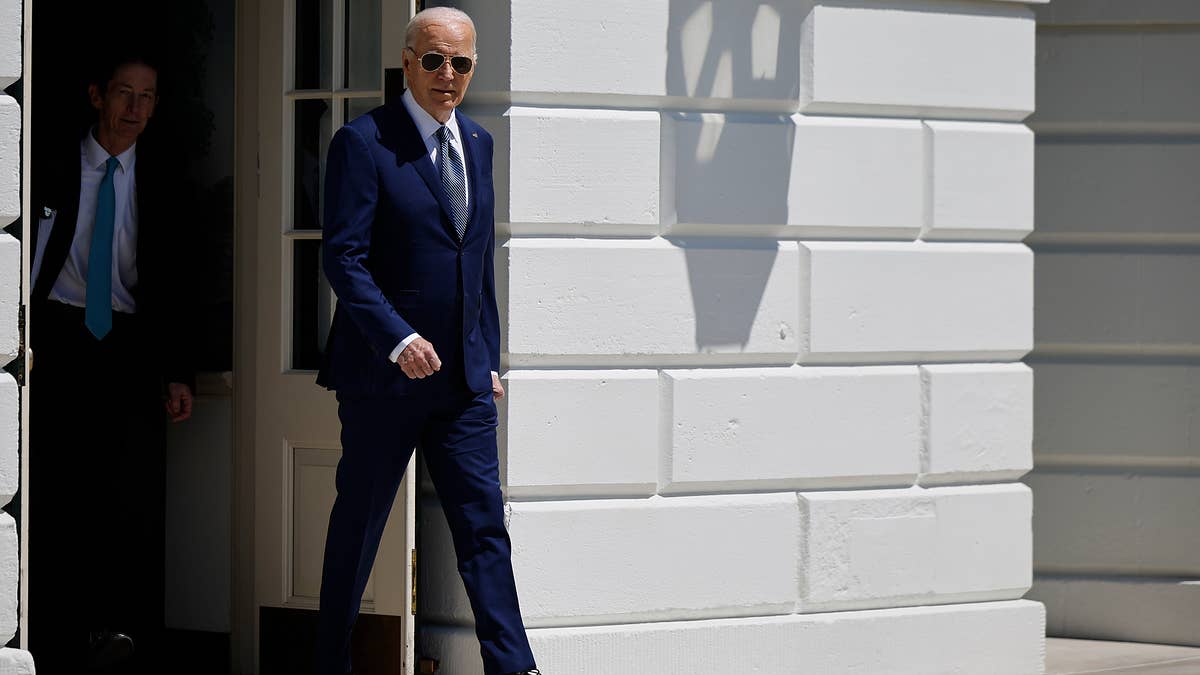
| BY TRACE WILLIAM COWEN
Biden Says He Thought About Jumping From Delaware Memorial Bridge After 1972 Deaths of Wife and Daughter

| BY JOSHUA ESPINOZA
Monica Lewinsky Uses Taylor Swift "Asylum" Meme to Joke About Her White House Scandal

| BY JAELANI TURNER-WILLIAMS
Aaron Carter's Twin Sister Says 'Generational Dysfunction' Led to the Deaths of Three of Her Siblings

Dolphin Found Shot to Death on Louisiana Beach, 'Multiple Bullets' Lodged in Carcass
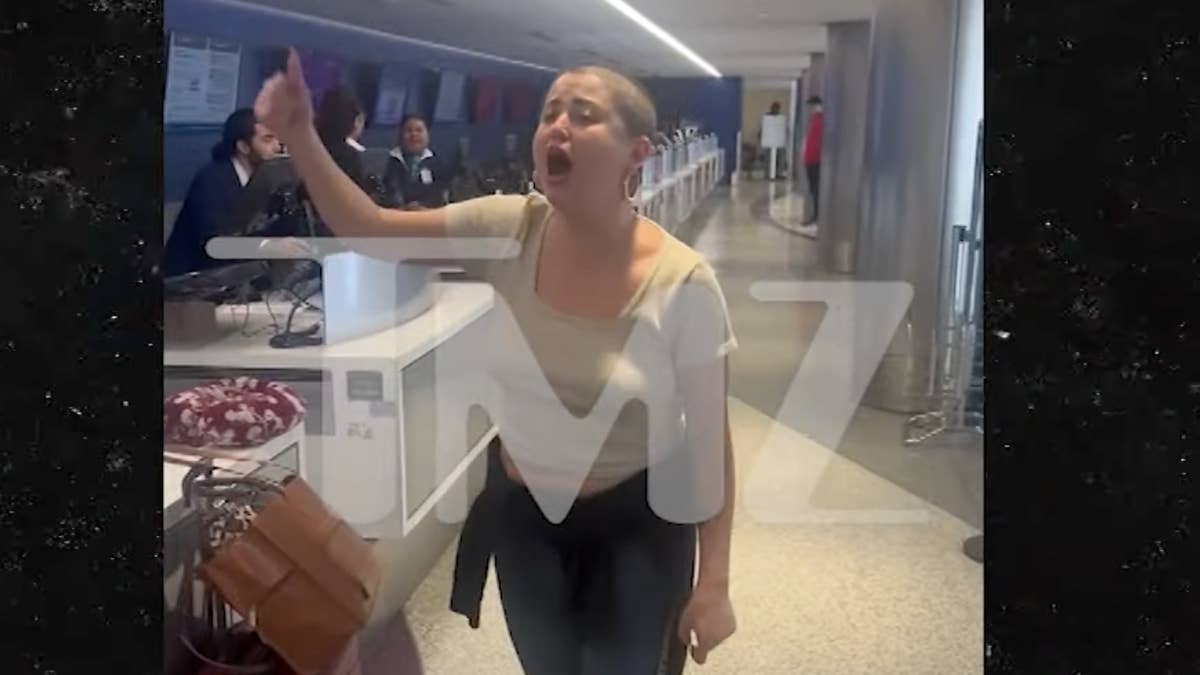
| BY JOSE MARTINEZ
Woman Filmed Cursing Out LAX Employees Before Learning She's Shouting at the Wrong Airline

| BY JOE PRICE
Soulja Boy Offers to Buy TikTok After Biden Signs Bill Signaling Potential U.S. Ban
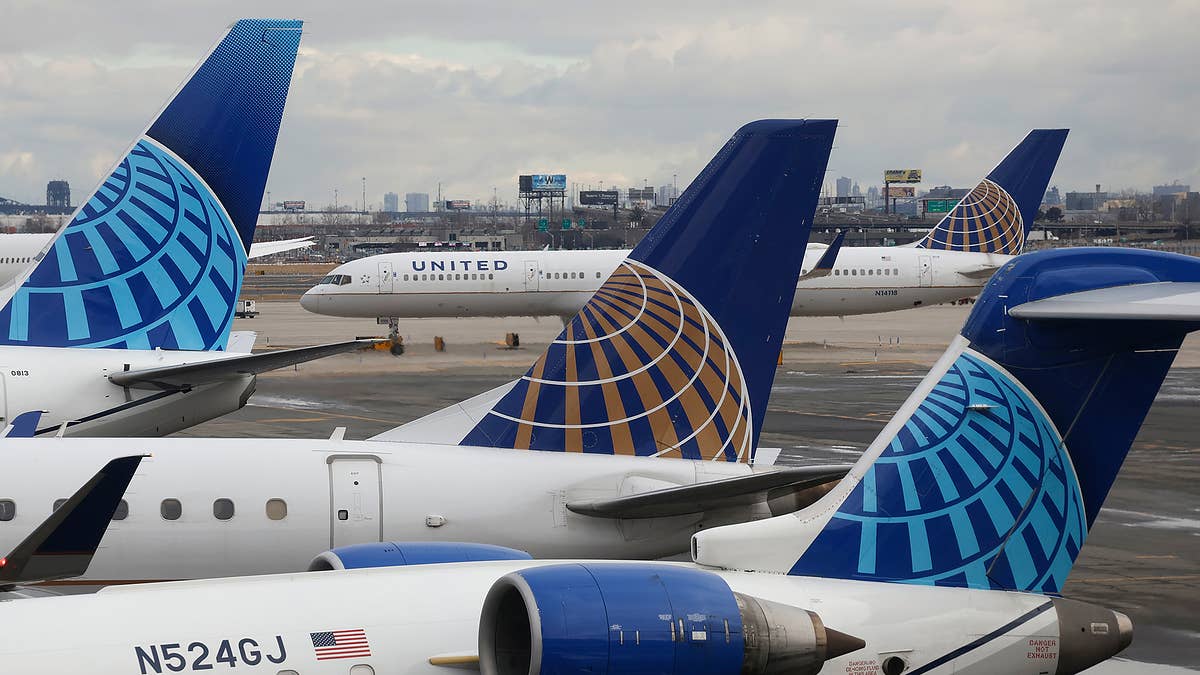
Department of Transportation Says Airlines Must Issue Refunds for Delayed or Cancelled Flights
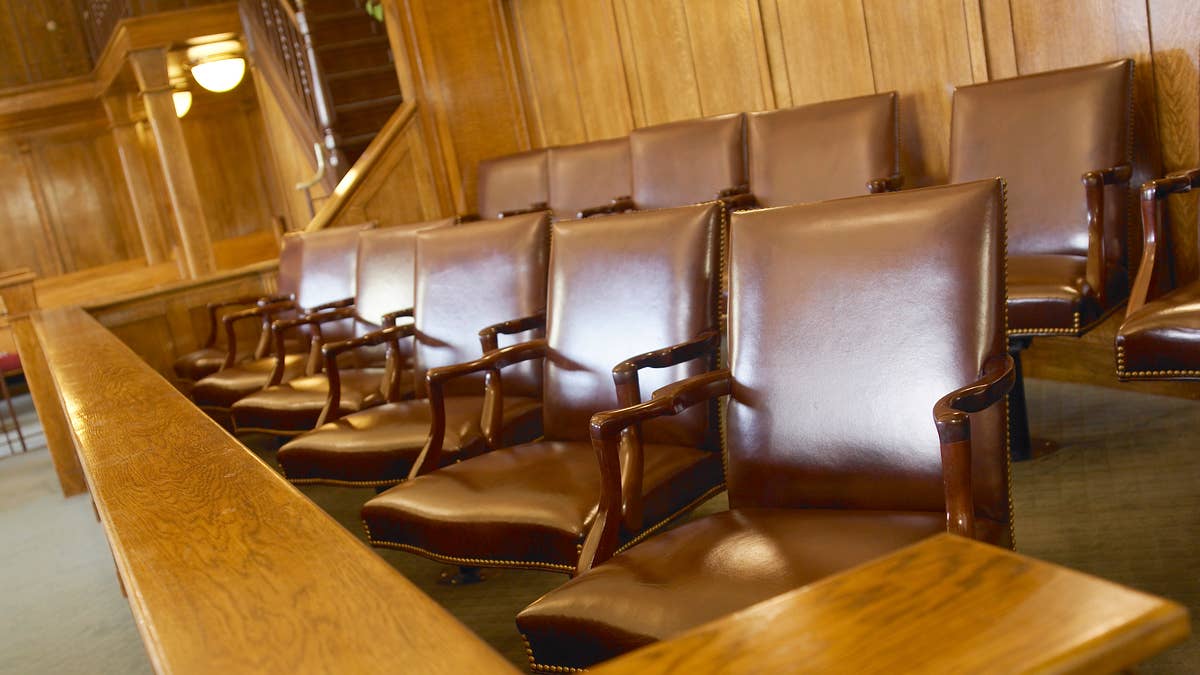
Death Penalty Cases in California Under Review After Evidence Reveals Jewish and Black Jurors Were Intentionally Excluded

Extremely Loud Cicadas Have South Carolinians Calling the Cops

10-Year-Old Texas Boy Confesses to Shooting and Killing Man in His RV

What to do if you find a hidden camera in your Airbnb, cruise cabin
"Safety in Travel” is a six-part series focusing on the travel safety tools available in different industries, how they can affect the overall experience, and how travelers can make use of them. If you'd like to contribute to our future reporting and share your experience as a source, you can click here to fill out this quick form .
When Saja Rafaeil first noticed shadows inside a bathroom stallon MSC Cruises' Meraviglia ship, she didn't think anything of it. She and her husband were on a sailing that visited Mexico and the Bahamas when she got up use the restroom one night as they were relaxing in a lounge onboard.
"I tried to ignore (the shadows)," she said. Then she saw a hand holding a cellphone reach underneath and upward. "And then that's when I freaked out a little bit."
Start the day smarter. Get all the news you need in your inbox each morning.
Saja, who asked to be identified only by her first and middle names because of the nature of the incident, alerted a crew member outside the bathroom who came inside and knocked on the stall door, along with another passenger she had met onboard. Saja also began filming on her phone so she'd have evidence, and she posted the video on TikTok . When the door opened, a male crew member walked out.
Check first: How to spot hidden surveillance cameras in your Airbnb, VRBO, or vacation rentals
Even if the seatbelt sign is off, you should stay buckled while flying: Here's why
Saja and her husband had a couple days left, including a sea day, before arriving back at Florida's Port Canaveral. "And after that, I just felt so violated that I needed to go back to my room ... and for the next two days (on) the ship I was kind of just in my room," she said.
Saja is among a number of travelers who say they have been filmed or spied on while traveling, whether by a covert culprit or via a hidden camera in their accommodations.
"We are aware of the incident on board MSC Meraviglia and our security team fully cooperated with authorities on this investigation," an MSC spokesperson said in an emailed statement. "We took immediate action to terminate employment of (the) crew member involved and support the impacted guests. The safety and comfort of our guests and crew is our top priority, and we have a zero-tolerance policy for any misconduct on board our ships."
Saja filed a report both with MSC and the Brevard County Sheriff's Office in Florida. A spokesperson for the sheriff's office said in an email that based on information from the draft report, it has not been finalized.
"The suspect did not admit to filming the victim and a search of the suspect’s phone did not locate any video or photos of the victim," the spokesperson added.
Cruise ships are subject to the laws of the place where the vessel is flagged, said Michael Winkleman, a maritime attorney with Lipcon, Margulies & Winkleman, P.A.
"More often than not, these foreign countries have invasion of privacy laws that are similar to the US.," he said in an email. "As such, it is similarly illegal to have hidden cameras on cruise ships."
How often are people spied on while traveling?
The exact number of incidents is "hard to quantify," because many people do not know they are being filmed or do not report it, said Carrie Pasquarello, CEO and co-founder of Global Secure Resources Inc., a company focused on risk mitigation and threat assessment planning.
Voyeurism, sextortion, extortion and blackmail are among the most common reasons travelers may be filmed without their knowledge or consent, according to Pasquarello. In some cases, those filming may livestream the video to viewers or threaten to expose the footage if those filmed do not give them money or participate in making more sexually explicit content, she said. A 2018 lawsuit claimed a woman was secretly filmed in the shower at a Hilton hotel and extorted for money. The case is still active.
Generally, it is illegal to have cameras in private spaces like bedrooms and bathrooms in hotels or other lodging the U.S., according to Pasquarello, though exact laws may vary by state.
Doctor onboard?: What happens if you get sick or injured (or bitten by a monkey) on a cruise ship
Ding! Even if the seatbelt sign is off, you should stay buckled while flying. Here's why.
"The location of the cameras, their purpose, and the distribution or publishing of the video are the key factors in these cases," said Lawrence J. Buckfire, attorney for and president of Buckfire Law , a Michigan-based personal injury law firm. His firm has handled several cases where guests found hidden cameras in their hotel rooms and vacation rental properties. "A hidden camera at a main entrance area for security purposes or basic monitoring is generally not actionable in a lawsuit, but a hidden camera in a bedroom or bathroom to capture can provide a basis for a lawsuit."
Does Airbnb allow cameras on rental properties?
Airbnb allows cameras to offer "peace of mind" for security, but they must be disclosed prior to booking, installed in a visible manner and not infringe on anyone's privacy.
Cameras are allowed only in "public spaces and common spaces," not including a living room that has a sofa bed, according to Airbnb's community policies. However, "disconnected devices are allowed as long as they are turned off and proactively disclosed to guests."
Fellow rental platform Vrbo allows "reasonable monitoring outside of the property" and bans any surveillance devices inside.
Overboard systems: What are cruise ship overboard detection systems and why doesn't every ship have them?
Unsure of what meds you need before an international trip? Here's how your pharmacist can help.
What happens if you encounter a camera at your rental?
Last year, Alyssa Casamento booked an Airbnb in Poughkeepsie, New York, for a reunion trip with her college friends. She said the reviews for the rental were good, although once booked, "things were just very odd from the start."
When her friend arrived first at the Airbnb, the door code Casamento was given wasn't working. Suddenly, a man started talking to her over the camera doorbell and gave a different code, Casamento said.
Her friend went inside and the host started texting her friend to take her sneakers off when in the house.
"The specificity of sneakers is a red flag," Casamento said. "That just gave me chills."
Her friend walked around the rental and saw a camera in the corner of a bedroom facing directly at the bed. She started to search for more cameras and found one "very conveniently placed" behind a curtain in the living room facing the couches.
"Once I heard that, I was like you need to leave. She's there by herself, I'm obviously terrified for her," Casamento said. The group ended up booking a different hotel, and Casamento called the incident "very unsettling."
Casamento filed a complaint to Airbnb and said she was dismissed at first since the listing disclosed cameras.
"No, it says they're outdoor cameras not cameras facing where I'm going to sleep tonight," she said. The company called her the next day to apologize, investigated the property and refunded her for the booking and hotel in about a month.
"We removed this listing from the platform last year following our investigation due to the violations of our strict camera policy," Airbnb spokesperson Ben Breit said.
"I'm fairly confident, just based on the comments I saw on my TikTok , that it was a one-off thing, but make no mistake, every Airbnb, hotel, I'm booking from now on, I'm scouring floor to ceiling," she said.
Is Airbnb safe?: Check for these four red flags to avoid scams as a guest on your next stay
Are theme park rides safe?: What you should know if you're worried about accidents.
Pasquarello recommended guests do research via Google on what spy cameras look like before their trip. "You have to know the risks to avoid the risks," she said, noting that cameras can be hidden in a range of items, including lamps and smoke detectors.
Once you're in your room, consider doing a "quick sweep," Pasquarello added, and unplug and stash or cover any items not needed.
"If I'm in a hotel, and there's a radio clock that I'm not using, I'm putting all the electronics I'm not using into a closet," she said.
Buckfire recommended guests inspect air vents and look for any small holes in the walls or ceilings. You can also turn off the lights and use a cellphone flashlight to look for any lens reflections.
What to do if you are spied on while traveling
► If you find a hidden camera in your accommodation or that you are being filmed, Buckfire said to take photos or videos for evidence and then contact the owner of the Airbnb, cruise ship or hotel management.
"An owner that is using cameras for lawful security and property safety purposes should be truthful and acknowledge the presence of the cameras," he said.
► Both Buckfire and Pasquarello recommended reporting the incident to law enforcement.
"If you're in the States, that would be your non-emergency police number," Pasquarello said. On a cruise ship or in a hotel, guests can report the incident to security. If travelers are overseas at the time, she said, they can also call the nearest U.S. embassy.
► Pasquarello also urged travelers to ask for a copy of the police report, both for insurance purposes and so they understand how the crime was documented.
Are theme park rides safe?: What you should know if you're worried about accidents
What are cruise ship overboard detection systems: And why doesn't every ship have them?
► If a traveler encounters someone spying on them in real time, she said they should get to safety and find someone to help them. "There's a lot of escalation that can happen in a situation like this," Pasquarello said.
► When crimes like those occur, Winkleman said, travelers "can press charges against the perpetrator and then the matter is in the hands of the prosecuting authority." Travelers can seek to hold the perpetrator and the hotel, cruise line or other company civilly responsible and pursue monetary damages, as well, he said.
"Any person who was the subject of non-consented videotaping in a hotel room or vacation rental may be able to file a civil lawsuit against the property owner," Buckfire said. "Damages in these cases include money compensation for mental anguish and psychological trauma resulting from the invasion of privacy. These damages include embarrassment, humiliation, mortification, anxiety and PTSD.
"People should act in these situations to hold property owners and others accountable for their unlawful conduct," he added. "Without such accountability, other guests in the future will be subject to having their privacy invaded."
For Saja, who is a frequent traveler, the experience soured her on cruising a bit, though perhaps only temporarily. "I mean, it just puts a bad taste in my mouth right now," she said. "But I'm sure with time, I'll be fine."
Have you been spied on during a vacation?
This article originally appeared on USA TODAY: What to do if you find a hidden camera in your Airbnb, cruise cabin
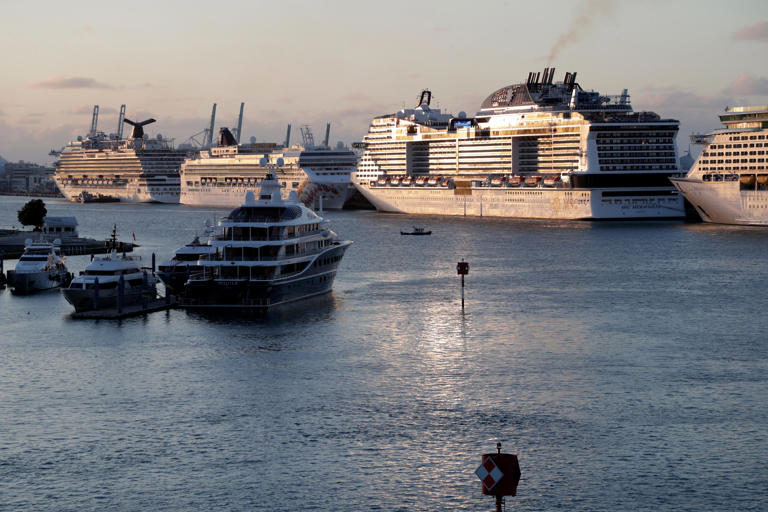
Gisele Bündchen breaks down in tears during Florida traffic stop while fleeing paparazzi
Gisele Bündchen broke down in tears while telling a Florida police officer that she was trying to escape paparazzi when she was pulled over.
The supermodel was stopped earlier this week while driving in Surfside, police body camera video shows. When the officer asks that she roll down the window, she says, "But the paparazzi is right there."
Bündchen tells the officer that she was "just trying to escape from that guy."
"I understand who you are," the officer responds. "There's nothing I can do about that."
The officer then tells her, "I'll give you a courtesy today."
Bündchen, who moved to Florida following her divorce from NFL quarterback Tom Brady , tells the officer that she feels like the guy is "stalking" her and breaks down in tears.
"Nothing protects me. I can't do nothing," an emotional Bündchen says. "I just want to live my life!"
The officer explains that he cannot prevent the paparazzi from "doing their job" and photographing her and suggests that she file a report with police in Miami Beach since the incident started there.
It's not clear if Bündchen filed a report.
Minyvonne Burke is a senior breaking news reporter for NBC News.

IMAGES
VIDEO
COMMENTS
Tap on Camera Settings. 3. Tap on Auto-Cruise. 4. Enable the Auto-Cruise feature. 5. Once the auto cruise is on, you can select Cruise Route or Cruise period mode. 6. The Cruise Route - stops for 10 seconds at all bookmarked locations.
YI Dome Camera offers two cruise modes: 360° Panoramic cruise - When you turn on this mode, the camera will automatically rotate at a set speed at 20° intervals, resting for 10 seconds between each turn. Preset cruise - When you turn on this mode, the camera will automatically generate a cruise path based off your saved camera positions.
By using one of the pan/tilt cameras that has this specific function, you can quickly check those locations with a single click in the eufy Security app. The Auto-Cruise function allows the camera to automatically rotate between these preset positions, providing a comprehensive view of your property. Please note that this function is turned off ...
Preset cruise - When you turn on this mode, the camera will automatically generate a cruise path based off each bookmark location. The camera will stay at each position for 10 minutes. There must be a minimum of 2 and a maximum of 8 camera positions. You can set the Cruise time, repeat, interval and speed in the Auto Cruise page.
Auto-Cruise feature configures Floodlight Camera 2 Pro to scan area according to different positions you personally set. The camera will automatically start tracking and recording when motion is detected in the scanning area. How to Enable the Auto-Cruise Feature. Step One: Set "Preset Positions" in Monitoring Settings.
Currently YI Dome Camera 1080p supports two cruise modes: 360° Panoramic Cruise: When you turn on this mode, the camera will automatically rotate at a set speed at 20° each time, pause for 10 seconds and then start cruise again. Preset Position Cruise: When you turn on this mode, the camera will automatically cruise through the preset ...
Cruise LLC is an American self-driving car company headquartered in San Francisco, CaliforniaFounded in 2013 by Kyle Vogt and Dan Kan, Cruise tests and develops autonomous car technology. The company is a largely autonomous subsidiary of General Motors. Following a series of incidents, it suspended operations in October 2023, and the CEO resigned in November 2023.
BlueCruise will use a driver-facing camera to make sure you're paying attention while the system is operating. It will also let you drive completely hands free while it's activated. GM Super Cruise
ACC uses radar, laser sensors or cameras to monitor the vehicle ahead and adjust your speed accordingly to maintain a preset following distance. If the vehicle in front slows, so does your car - automatically! ACC reduces the constant manual braking and acceleration required in heavy traffic.
GM rolled out a new "Hands Free, Eyes On" campaign late last week.; The point is to educate people about the Super Cruise driver-assist technology in new and upcoming Cadillac, Chevrolet, GMC, and ...
Learn the basics of how a Cruise car navigates city streets safely and efficiently. Cruise 101. Look. Sensors can see 360 degrees, hundreds of feet ahead, and around that double-parked car. Cruise cars make sense of this data in a split second, tracking every important object in view. Cruise 101.
MIAMI -- Supermodel Giselle Bundchen was caught on police body camera video breaking down in tears during a recent traffic stop. She said it happened after she was being chased by paparazzi.
With cruise control, drivers need to brake to slow down as they close in on a slower vehicle in traffic. With adaptive cruise control, the system makes these braking inputs automatically, and the ...
So pack your bags and get ready to set sail with the best camera equipment for cruise vlogging. GoPro Hero 11 A GoPro camera is a must-have for first-time cruisers, providing a compact and durable option to capture unforgettable moments on and off the ship.
In-car cameras first started appearing in luxury vehicles close to two decades ago, and in recent years they've become more commonplace—so much so that they'll soon be mandatory in Europe.
Each car with Super Cruise has a network of cameras and radar sensors plus high-accuracy GPS that can pinpoint your position within 3 feet, said Kevin Kelly, an advanced technology spokesman at GM.
Adaptive cruise control (ACC) is an intelligent form of cruise control that slows down and speeds up automatically to keep pace with the car in front of you. The driver sets the maximum speed ...
GM's first-generation advanced driver-assist system (ADAS), Super Cruise, has been praised as a safer, more capable version of Tesla's Autopilot, thanks to its camera-based driver monitoring ...
Adaptive cruise control takes it to the next level. It maintains a set speed for your vehicle, like a conventional cruise control system, but it also adjusts the speed based on the traffic flow ...
5. 2020 Toyota Corolla Hatchback. This new model provides drivers with an adaptive cruise control system, specifically designed for highway travel. Its cruise control features include cameras ...
Cruise's Sensor Placement Tool accurately enables the virtual placement, evaluation, and iteration of various sensor layouts across three sensor types: camera, radar, and LiDAR. We have accurately modeled the camera's field of view and distortion, radar field of view, range and point cloud distribution, and LiDAR beam distribution and ...
A kidnapping suspect in Oregon has been arrested after doorbell camera video captured him grabbing a woman and hauling her to a car. Police shared stills of the video, which helped them identify ...
The last part of the sensor array is the driver-attention system. There is a small camera that's located on the top of the steering column — right in front of the car's instrument panel — that ...
Cruise Automation is a self-driving car company whose goal is to deploy safe self-driving cars at scale. Founded in 2013, they develop self-driving cars that can take passengers from A to B in a safe and comfortable way. I got interested in their system and watched a few videos and interviews to get back to you with a concise analysis.
Using forward-facing sensors such as radar and/or cameras, adaptive cruise control (ACC) detects a vehicle in front of you and, working in concert with the brakes and powertrain, automatically adjusts your vehicle's speed to maintain a safe following distance. This high-tech feature is available on many new cars and can make highway driving ...
Autopilot involves using Tesla's Traffic-Aware Cruise Control, which matches the speed of other traffic, and Autosteer, which helps keep the vehicle within a lane but drivers are supposed to have ...
A Texas mother is facing time behind bars after allegedly leaving her young children home alone while she went on vacation. As reported by KHOU 11, Lakesha Woods Williams is facing a child ...
"A hidden camera at a main entrance area for security purposes or basic monitoring is generally not actionable in a lawsuit, but a hidden camera in a bedroom or bathroom to capture can provide a ...
One person is dead and several others injured after a shuttle bus rammed into them at a Honolulu cruise terminal in Hawaii on Friday, according to police and Carnival Cruise Line. The cruise port ...
"Nothing protects me. I can't do nothing," an emotional Bündchen tells the officer in body camera video. "I just want to live my life!"